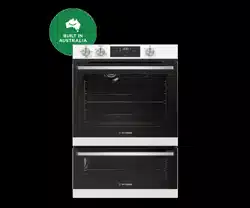Documents: Go to download!
- User Manual - (English)
- PRODUCT DESCRIPTION
- USING YOUR OVEN
- COOKING GUIDE
- GRILLING GUIDE
- DEALING WITH COOKING PROBLEMS
- GETTING TO KNOW THE OVEN
- CLEANING YOUR APPLIANCE
- TROUBLESHOOTING
Table of contents
Owner's Guide Ovens
PRODUCT DESCRIPTION
WVG613

WVG615

WVG655 & WVG665

- Oven indicator light
- Function selector
- Oven/grill temperature selector
- ‘Auto-off’ timer
- Function indicator light
- Electronic Clock
- Oven temperature selector
- Grill indicator light
- Grill temperature selector
USING YOUR OVEN
Understanding your oven functions
Your oven will have a selection of the following functions. Refer to “Description of your appliance” to confirm what functions are available to you.
Oven
Refer to cooking guide for more information.
Fan Forced
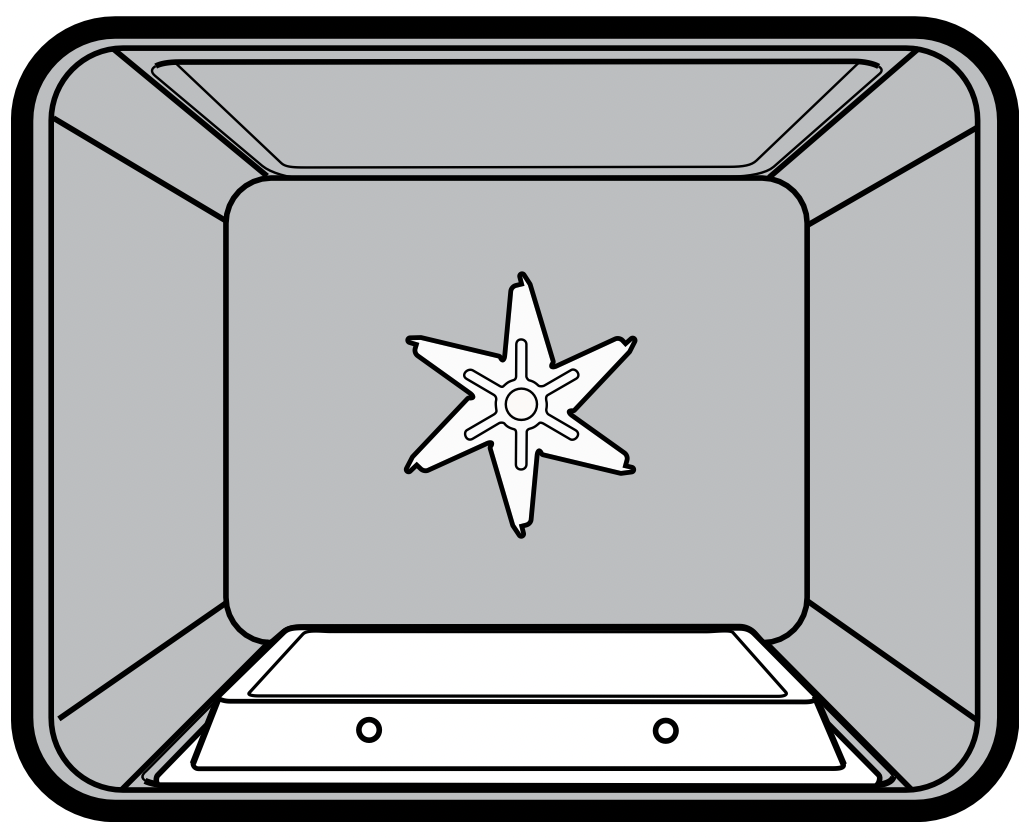
Heat comes from the gas “base heat” burner which is then circulated by the fan. This fan circulates the hot air around the oven cavity so that you can put your food in different places in the oven and still cook them at the same time.
You can use the “Fan Forced” function for multi-shelf cooking, reheating cooked foods, pastries and complete oven meals. It will cook at a lower temperature and be faster than baking. Please note that some variation in browning is normal.
Bake
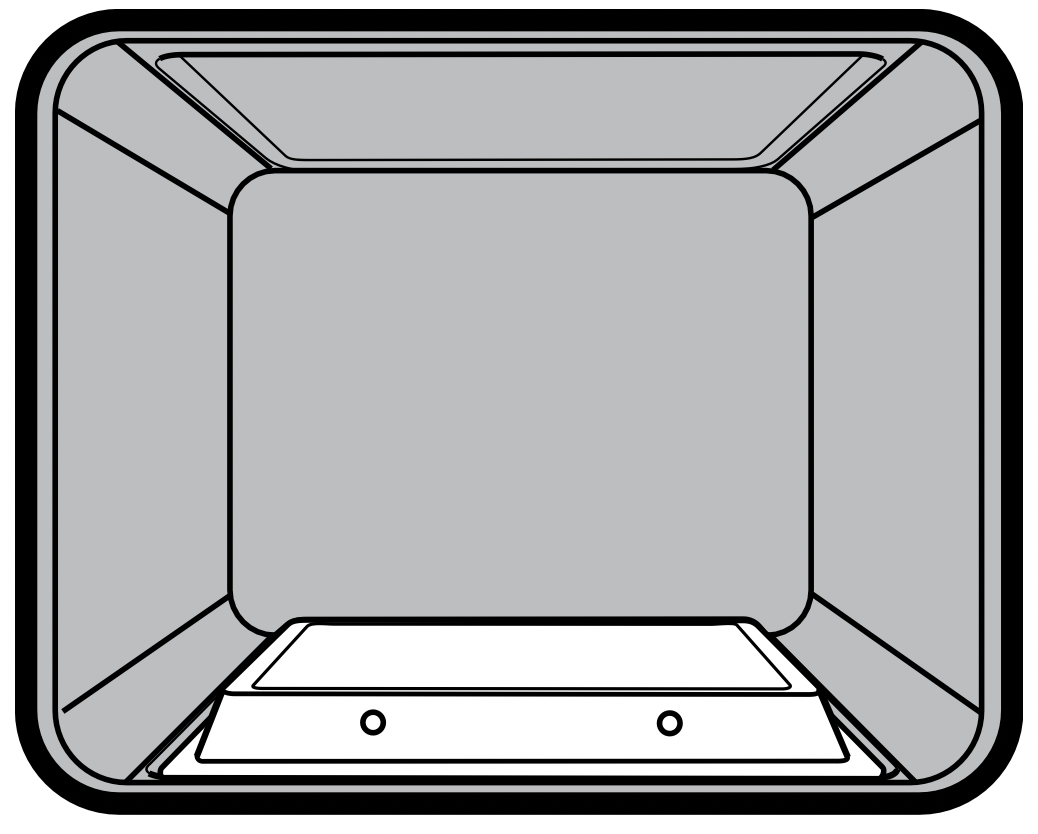
Heat comes from the gas “base heat” burner below the food. The bottom burner is below the floor of the oven which is controlled by the thermostat and will turn on and off to maintain the set temperature.
You can use the “bake” function for single trays of biscuits, scones, muffins, cakes, slices, casseroles, baked puddings, roasts and delicate egg dishes.
- For best results use silver or shiny trays.
Defrost
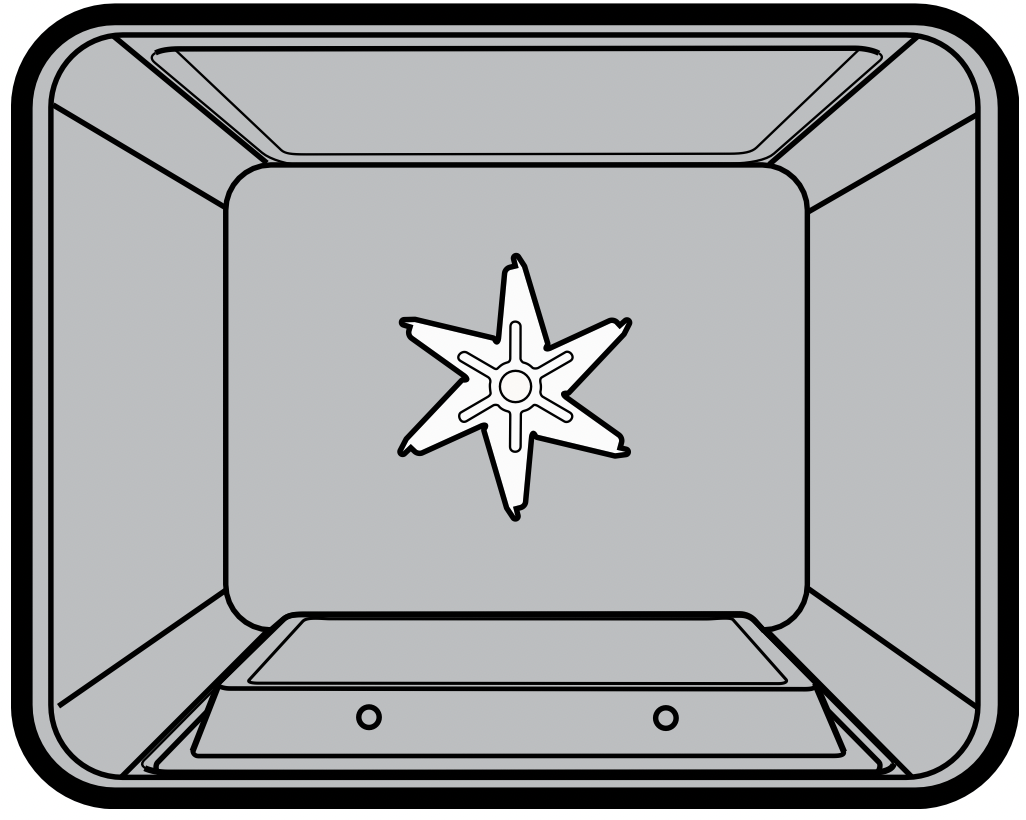
The “defrost” function uses low temperature air which is circulated by the fan. You can defrost (thaw) your food before you cook it. Also you may use your “defrost” to raise your yeast dough or to dry fruit, vegetables or herbs.
Grill
Refer to grilling guide for more information.
Grill (grill in oven models only)
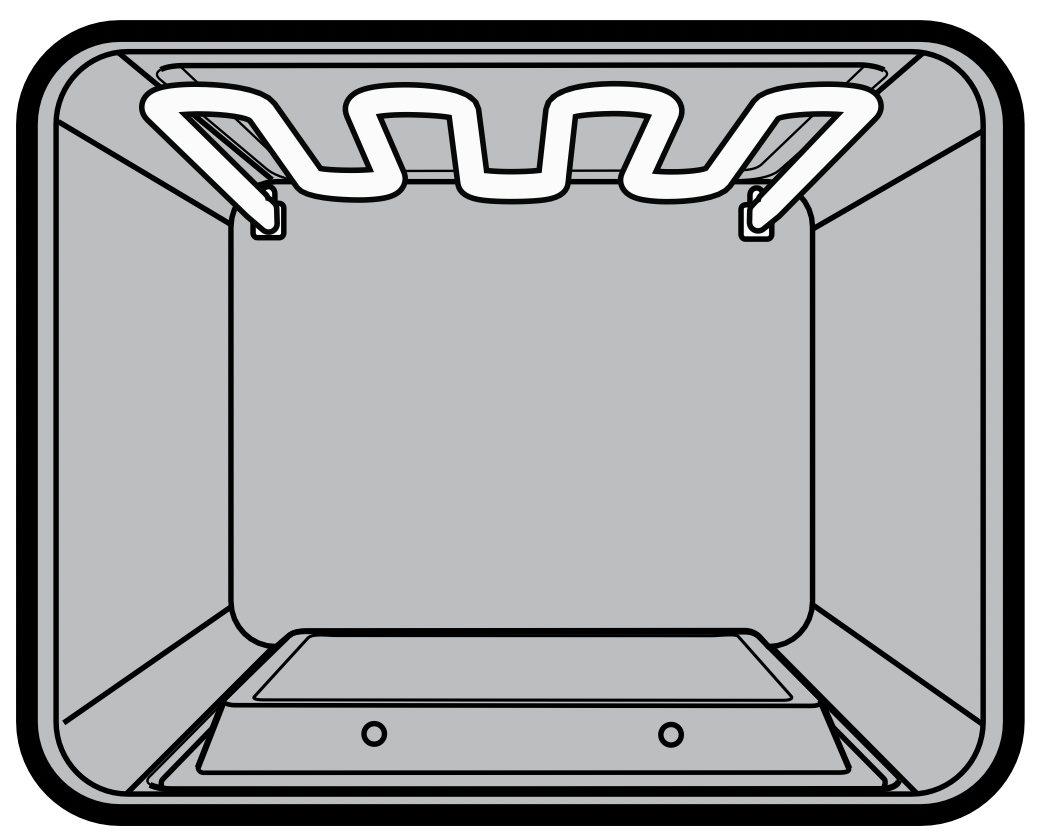
The “grill” directs radiant heat from the powerful upper element onto the food. You can use the “grill” function for tender cuts of meat, steak, chops, sausages, fish, cheese toasties and other quick cooking foods. Grill with the oven door closed. Preheat your grill for 3 minutes to get the best results. This will help seal in the natural juices of steak, chops etc. for a better flavour. You can slide your grill dish into either of the 2 spaces within the upper pairs of support rails.
Fan & Grill (grill in oven models only)

“Fan & Grill” offers you the benefits of both “bake” and traditional “grill” functions. The grill element turns on and off to maintain the set temperature while the fan circulates the heated air. The oven door remains closed for “Fan & Grill”. You can use “Fan & Grill” for large cuts of meat in the oven which gives you a result that is similar to “rotisserie” cooked meat. Put your food on a shelf in the second lowest shelf position. Put the grill dish on the lowest shelf position to catch any spills. When using “fan grill” it is not necessary to turn the food over during the cooking cycle. Set temperature to 180°C.
Separate grill (separate grill models only)

The “grill” directs radiant heat from the powerful upper element onto the food. You can use the “grill” function for tender cuts of meat, steak, chops, sausages, fish, cheese toasties and other quick cooking foods. Preheat your grill for 3 minutes to get the best results. This will help seal in the natural juices of steak, chops etc. for a better flavour.
For models with a separate grill, the door must be left open while grilling.
IMPORTANT
Cooling/Venting fan
Your built-in appliance is fitted with a cooling fan.
This prevents your kitchen cabinet from overheating and reduces the condensation inside the oven. It will operate whenever you are using your oven or grill and will blow warm air across the top of the oven or grill door.
NOTE: (Model WVG655 only) If the oven is still hot from cooking, the cooling fan will keep running to cool the oven down and will switch off automatically when cool.
Condensation
This appliance is supplied with an exclusive system which produces a natural circulation of air and the constant recycling of steam. This steam makes it possible to cook in a steamy environment ensuring that dishes are soft inside and crusty on the outside. This process also reduces cooking time and energy consumption. During cooking, steam may be produced and released when the door is opened. This is absolutely normal. When food is heated, it produces steam in the same way a boiling kettle does. When steam comes into contact with the oven door glass, it will condense and produce water droplets. To reduce condensation, ensure that the oven is pre-heated before placing food in the oven cavity. It is recommended that condensation is wiped away after each use of the oven.
The effects of dishes on cooking results
Dishes and tins vary in their thickness, conductivity, colour etc. which affects the way they transfer heat to the food.
- Aluminium, earthenware, oven glassware and bright shiny utensils reduce cooking and base browning.
- Enamelled cast iron, anodized aluminium, aluminium with non-stick interior and coloured exterior and dark, heavy utensils increase cooking and base browning.
- To increase base browning simply lower the shelf position. To increase top browning, raise the shelf position.
- Always place dishes centrally on the shelf to ensure even browning.
- Single level cooking gives best results in conventional modes. If cooking on more than one level use a fan cooking function.
Operating your oven temperature selector
A thermostat controls the temperature in your appliance. The temperature can be selected within the specified range. To set the temperature, turn the temperature selector in a clockwise direction to the desired setting. An indicator light above the temperature selector will come on and the oven burner will ignite. When the set temperature is reached, the gas burner flame goes out and the indicator light goes off. When the oven temperature falls below the set temperature the flame automatically re-ignites and the oven indicator light comes on again.
CAUTION: Once the food is cooked, turn the temperature selector back in an anti-clockwise direction. Do not force it right round in a clockwise direction as this will result in damage to the thermostat.
NOTE: For multifunction ovens the desired cooking function must be selected before the oven will operate. Once the desired function has been selected, use the temperature selector to set the required temperature.
Pre-heating your appliance
For best results when baking you must preheat your oven for 30 minutes. Preheat grill for 3 minutes to obtain best results. Pre-heating your appliance allows it to reach the required temperature quickly and efficiently.
When baking bread or cakes, load the oven as quickly as possible after pre-heating, only leaving the oven door open for the shortest time. This will minimise loss of heat from the oven and ensure the best results.
With “bake” or “fan forced bake”
- It is recommended you preheat your appliance when cooking or baking.
- Set the desired preheat temperature, by rotating your oven temperature selector.
Once the oven has been preheated, place your food into the oven, close the door and set the timer if you desire.
With “grill”
- Preheat the grill for at least 3 minutes to obtain best results. This will help to seal the natural juices of steak, chops and other meats for a better flavour.
Cooking with your timer
CAUTION: Set the timer clockwise. Do not force anticlockwise or damage to the timer will result.
120 minute “Auto off” timer
The 120 minute timer features an automatic oven cut off.
This means that a cooking period of up to 120 minutes can be set. When the timer has counted back to “Auto off”, a bell will sound and the oven will automatically switch off.
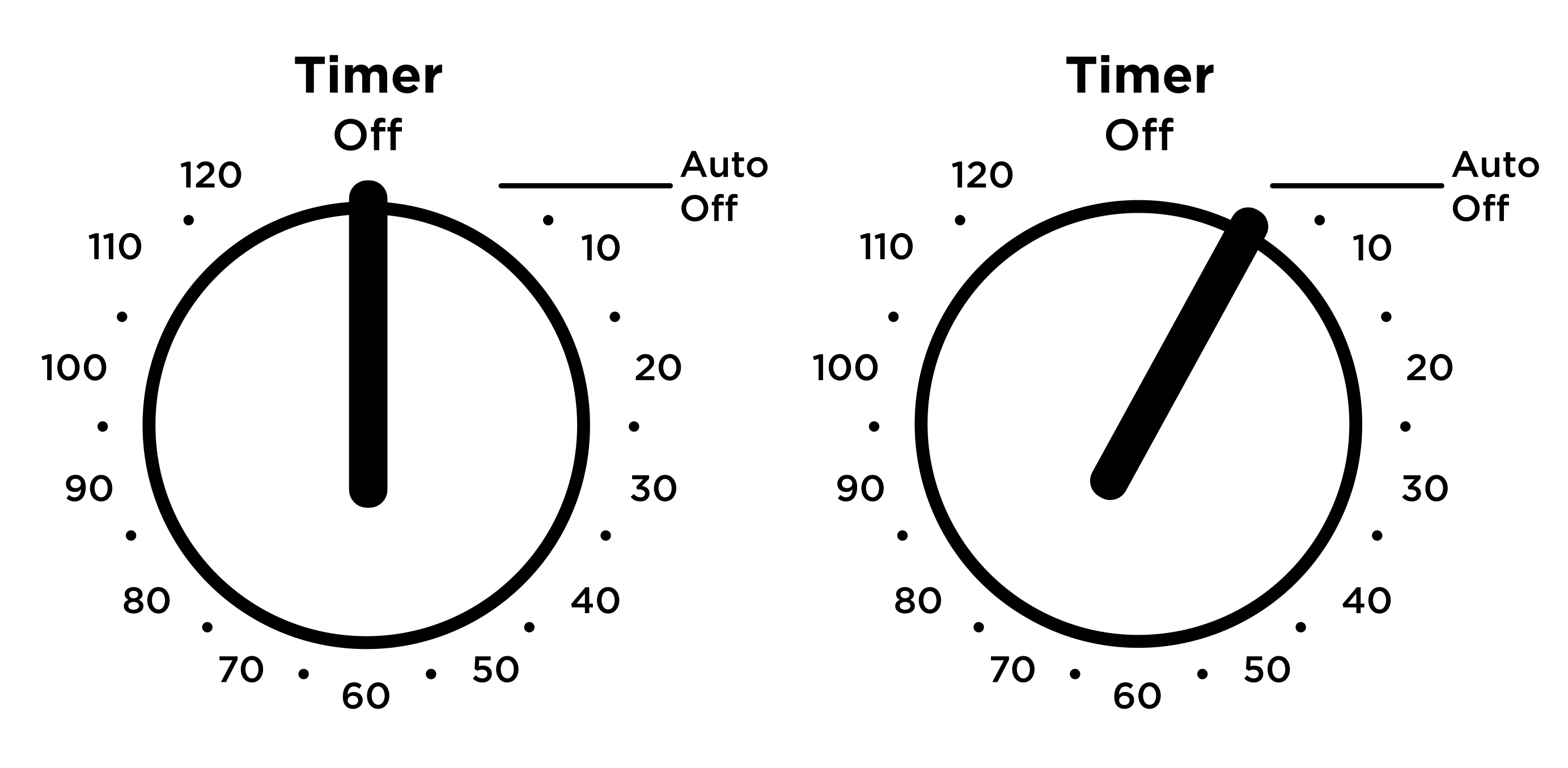
Once automatic baking is complete, return to manual operation by setting the timer to the “OFF” mark.
Operating the electronic clock (selected models only)
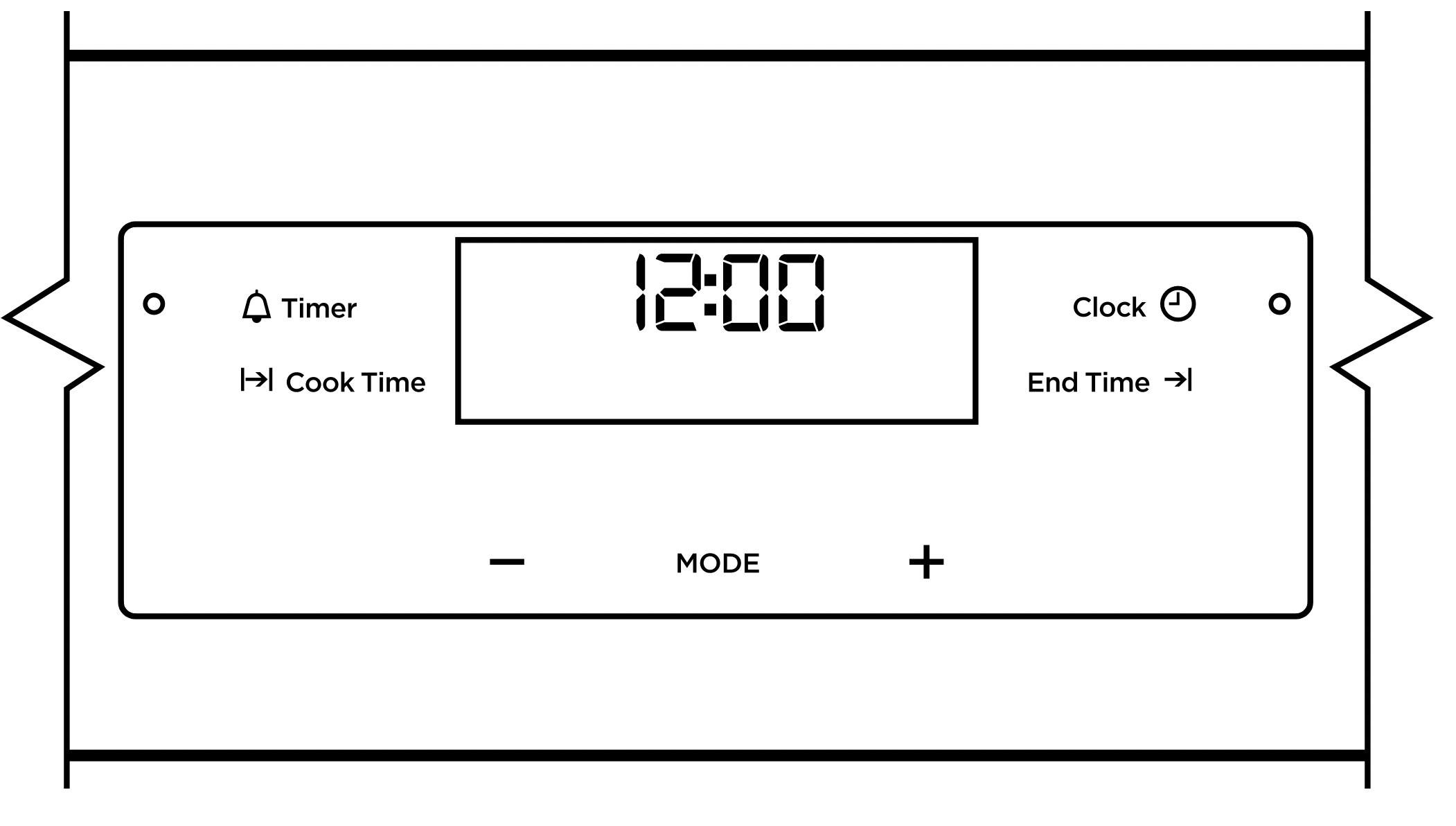
General features
The oven is equipped with an electronic clock that can be used to turn the oven on and off automatically. The Cook Time function automatically turns the oven off after a set amount of time. The End Time function is used to set the time of day you want the cooking cycle to finish. A “Delayed start” is possible by combining the Cook Time and End Time features to switch the oven on and off at a specific time during the day.
NOTE: Your touch control clock only operates with your main oven.
Setting the time of day (after electrical connection)
- After the appliance has been electrically connected, “12.00” will be displayed and the Clock indicator symbol
 will flash.
will flash. - To set the time of day, press the - or + symbols while Clock the indicator symbol
 is flashing.
is flashing. - After 5 seconds from the last change, the Clock indicator symbol
 will disappear, confirming the time has been set.
will disappear, confirming the time has been set.
NOTE: The clock has a 24-hour display.
Changing the time of day
- Press MODE until the Clock indicator symbol
 begins flashing.
begins flashing. - To set the time of day, press the - or + symbols while the Clokc indicator symbol
 is flashing.
is flashing. - After 5 seconds from the last change, the Clock indicator symbol
 will disappear, confirming the time has been set.
will disappear, confirming the time has been set.
Setting the minute minder
- Press MODE until the Clock indicator symbol
 begins flashing.
begins flashing. - Set the countdown time by using - or + symbols while the Timer indicator symbol
 is flashing.
is flashing. - After 5 seconds from the last change, the Timer indicator symbol
 will stop flashing, confirming the timer has been set. The countdown time remaining will appear on the display.
will stop flashing, confirming the timer has been set. The countdown time remaining will appear on the display. - Once the set time has elapsed, a beeper will sound for 1 minute. The time indication “0.00” and a flashing Timer indicator symbol
 will appear on the display.
will appear on the display. - To stop the beeper, press - , + symbols or MODE.
NOTE: This feature has no effect on the oven operation. With the minder operating, the time of day cannot be displayed.
Setting the cooking duration
- Select the desired oven Function and Temperature .
The oven indicator light will appear and the heating source will switch on. - Press MODE until the Cook Time indicator symbol
 begins flashing.
begins flashing. - Set the cooking duration by using - or + symbols while the Clock indicator symbol is flashing.
- After 5 seconds from the last change, the Cook Time indicator symbol
 will stop flashing, and the time of day will be displayed.
will stop flashing, and the time of day will be displayed.
NOTE: Do not forget to add pre-heating time if necessary.
Setting the cooking end time
- Select the desired oven Function and Temperature.
- Press MODE until the End Time indicator symbol
 begins flashing.
begins flashing. - Enter the time of day to finish cooking by pressing - or + symbols while the End Time indicator symbol
 is flashing.
is flashing. - After 5 seconds from the last change, the End Time indicator symbol
 will stop flashing and the current time of day will be displayed.
will stop flashing and the current time of day will be displayed.
Setting the delayed start cooking time
- Program the Cook Time and End Time as described in the relevant sections. Once both the Cook Time and End Time have been set, the Cook Time and End Time indicators will stop flashing and the current time of day will be displayed.
NOTE: Do not forget to add pre-heating time if necessary.
To check or cancel settings
- To check your settings, press MODE until the indicator symbol flashes next to the mode ( Cook Time, End Time, etc) that you want to display. After 5 seconds from the last change, the indicator will stop flashing and the time of day will be displayed.
- To cancel “delayed start”, press MODE until the indicator symbol
 flashes next to “End time”. Press and hold - or + symbols together until the current time of day is displayed.
flashes next to “End time”. Press and hold - or + symbols together until the current time of day is displayed. - To cancel a setting, press MODE until the indicator symbol flashes next to the setting to be cancelled. Press and hold - and + symbols together until the setting is cleared.
On completion of cooking
When the set time has elapsed, the oven will turn off, the timer will beep and the and/or indicators will flash.
- Turn the Function and Temperature controls to the off position.
- Press - or + symbols or MODE to stop the clock from beeping.
Switching the clock display ON and OFF
- Press together - and + symbols for 3 seconds to switch off the display.
- Press together - and + symbols for 3 seconds to switch the clock display on again.
NOTE: If a timer mode is set, then it is not possible to switch the display off.
Electronic burner control
Your gas oven is fitted with an electronic controller which manages the operation of the burner and monitors the flame. This controller includes features which ensure the safe operation of your appliance and will prevent the build up of unburnt gas should a fault occur.
It is normal for the flame to turn on and off during cooking to maintain a stable temperature in the oven. The thermostat indicator light indicates when the flame is on or igniting (indicator on), or when the flame is off (indicator off).
The burner flame can be seen by viewing through the 2 holes in the front of the burner cover.
Ignition and response to ignition failure
The electronic controller attempts to ignite the flame when an oven function and temperature is selected (the thermostat indicator light changes from off to on). The controller makes up to 2 attempts to ignite the flame, stopping if a flame is detected by the controller. If a flame is not detected after 2 attempts the burner and ignition are automatically switched off and a 90 second delay will occur. During this delay the controller does not respond to the “function” and “temperature” controls.
At the end of this delay, switch the Function or Temperature control off and leave off for at least 5 seconds. Then switch the Function and Temperature control on again to re-attempt ignition.
If the oven controls are left on when the delay ends then ignition is not attempted until the Function or Temperature control is first turned off for at least 5 seconds.
Response to flame failure
If the controller cannot detect flame due to a fault, then the controller will firstly respond by attempting to re-light the burner with a sequence of up to 3 attempts. If the re-lighting sequence is not successful the burner will be shut off.
The re-lighting sequence includes up to 3 attempts to re-light the burner, stopping if a flame is detected by the controller. If a flame is not detected after the re-lighting sequence the burner and ignition are automatically switched off and a delay of 90 seconds will occur. During this delay the controller will not respond to the “function” and “temperature” controls.
At the end of this delay, switch the Function or Temperature control off and leave it off for at least 5 seconds. Then switch the Function or Temperature control on again to re-attempt ignition.
If the oven controls are left on when the delay ends then ignition will not be attempted until the Function or Temperature control is turned off for at least 5 seconds.
Recognising a safety shut-down condition
During normal cooking the thermostat indicator light is on when the burner flame is igniting or on, and the thermostat indicator light is off when the flame is off.
If an oven function and temperature is selected and the thermostat indicator light is on, but the flame is not on or attempting to ignite, then the controller has invoked a safety shutdown of the burner and a 90 second delay will occur. During this delay the controller does not respond to the “function” and “temperature” controls.
At the end of this delay, switch the Function or Temperature control off and leave off for at least 5 seconds. Then switch the Function or Temperature control on again to re-attempt ignition.
Power failure
In the event of an interruption to mains power, the restoration of power will not cause the burner to re-ignite if the controls were left on. However the grill element will resume heating on models which do not have an electronic clock.
To resume operation of the appliance after the power has been restored:
- If the appliance has an electronic clock then set the time of day on the electronic clock.
- Switch the Function or Temperature control off and leave off for at least 5 seconds. Then switch the Function and Temperature control on again to re-attempt ignition.
Normal operation of the appliance will now resume.
Oven shelves
IMPORTANT
- Select the correct shelf location for food being cooked.
- Make sure dishes will fit into the oven before you switch it on.
- Keep edges of baking dishes at least 40mm from the side of the oven. This allows free circulation of heat and ensures even cooking.
- Do not open the oven door more than necessary.
- Do not place foods with a lot of liquid into the oven with other foods. This will cause food to steam and not brown.
- After the oven is turned off it retains the heat for some time. Use this heat to finish custards or to dry bread.
- Do not use a lot of cooking oil when roasting. This will prevent the splattering of oil on the sides of the oven and the oven door. Polyunsaturated fats can leave residue which is very difficult to remove.
- When cooking things which require a high heat from below (e.g. tarts), place the cooking dish on a scone tray in the desired shelf position.
- For sponges and cakes use aluminium, bright finished or non-stick utensils.
- Always remove unnecessary trays or dishes when roasting or baking.
Oven shelf location
The oven has 5 positions for shelves (as shown in the diagram below). To give maximum space above and below the shelves, load them in this way:
When cooking with 1 shelf, position at 1 or 2.
When cooking with 2 shelves, position them at 2 and 4.
For more detailed shelf locations. Refer to cooking tables for individual cooking functions.
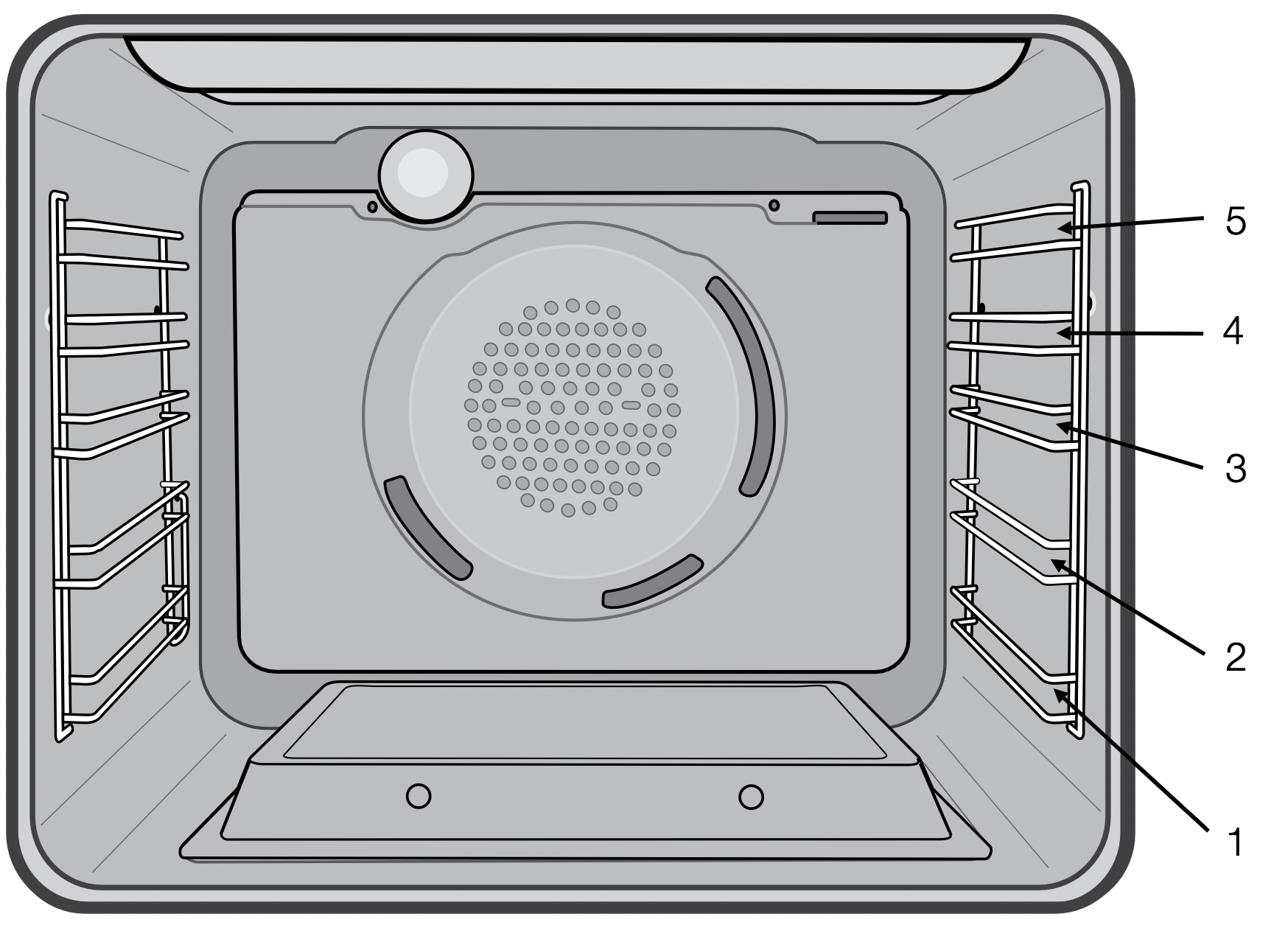
Roasting meat
- Place the meat in the oven and set the temperature between 180°C and 200°C. (It is recommended to wrap your meats in an oven roasting bag or foil to prevent fats and oils from splattering, making it easier to clean your oven.)
- Use the grill/oven dish and grill insert. Place the meat on the insert.
- Do not pierce the meat, as this will allow juices to escape.
- When the meat is cooked, take the roast out of the oven, wrap in aluminium foil and leave to stand for about 10 minutes. This will help retain the juices when the meat is carved. The table shows temperatures and cooking times for different kinds of meat. These may vary depending on the thickness or bone content of the meat.
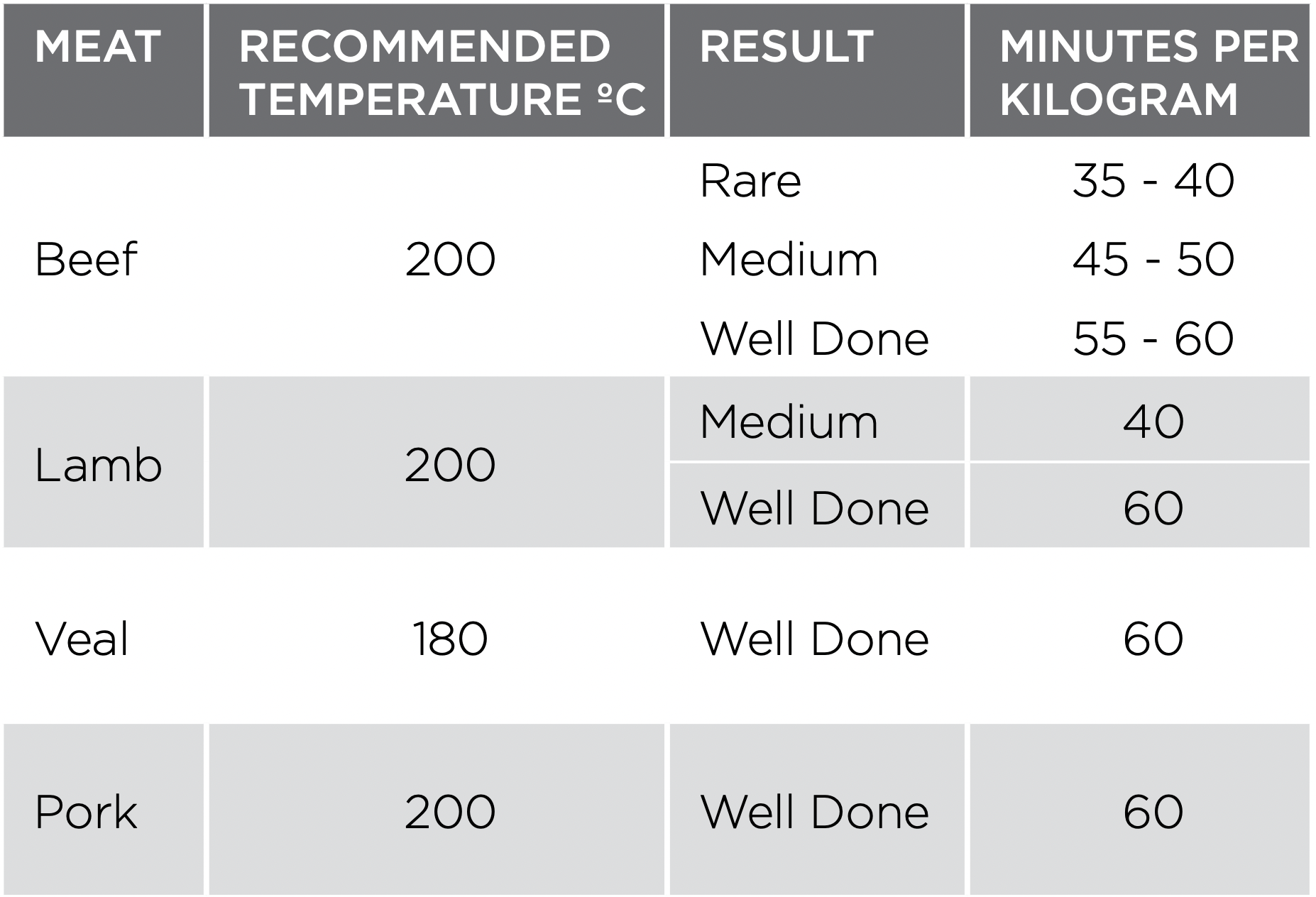
Roasting poultry and fish
- Place the poultry or fish in an oven set at a moderate temperature of 180°C.
- Place a layer of foil over the fish for about three quarters of the cooking time.
The table shows temperatures and cooking times for different kinds of fish and poultry. These may vary depending on the thickness or bone content of the meat.
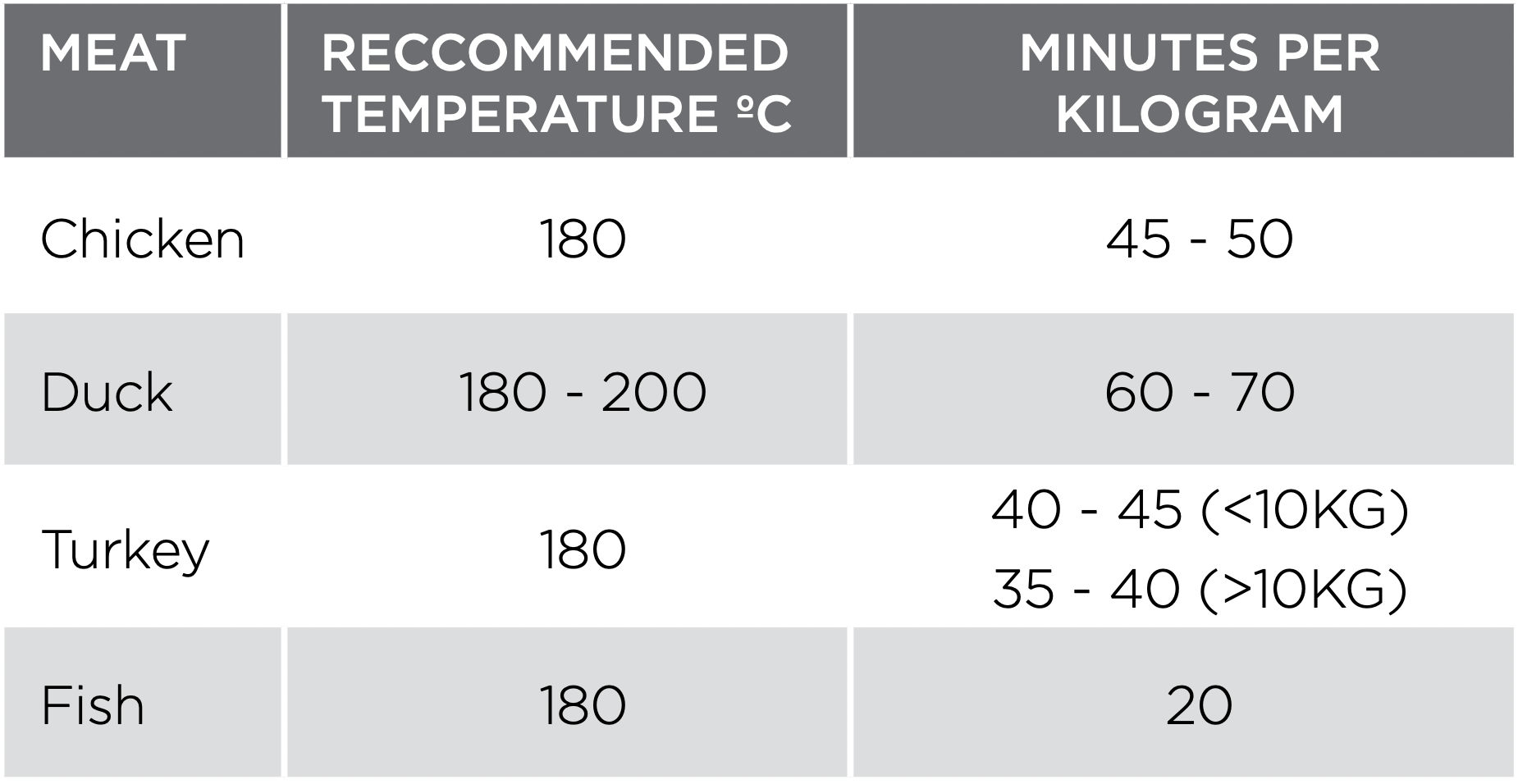
COOKING GUIDE
Choosing the best oven settings
The following table is intended as a guide and experience may show some variation in cooking times necessary to meet individual requirements. It may be necessary to change some cooking times and temperatures from your previous oven. For best results when baking preheat your oven for 30 minutes.
Conventional cooking
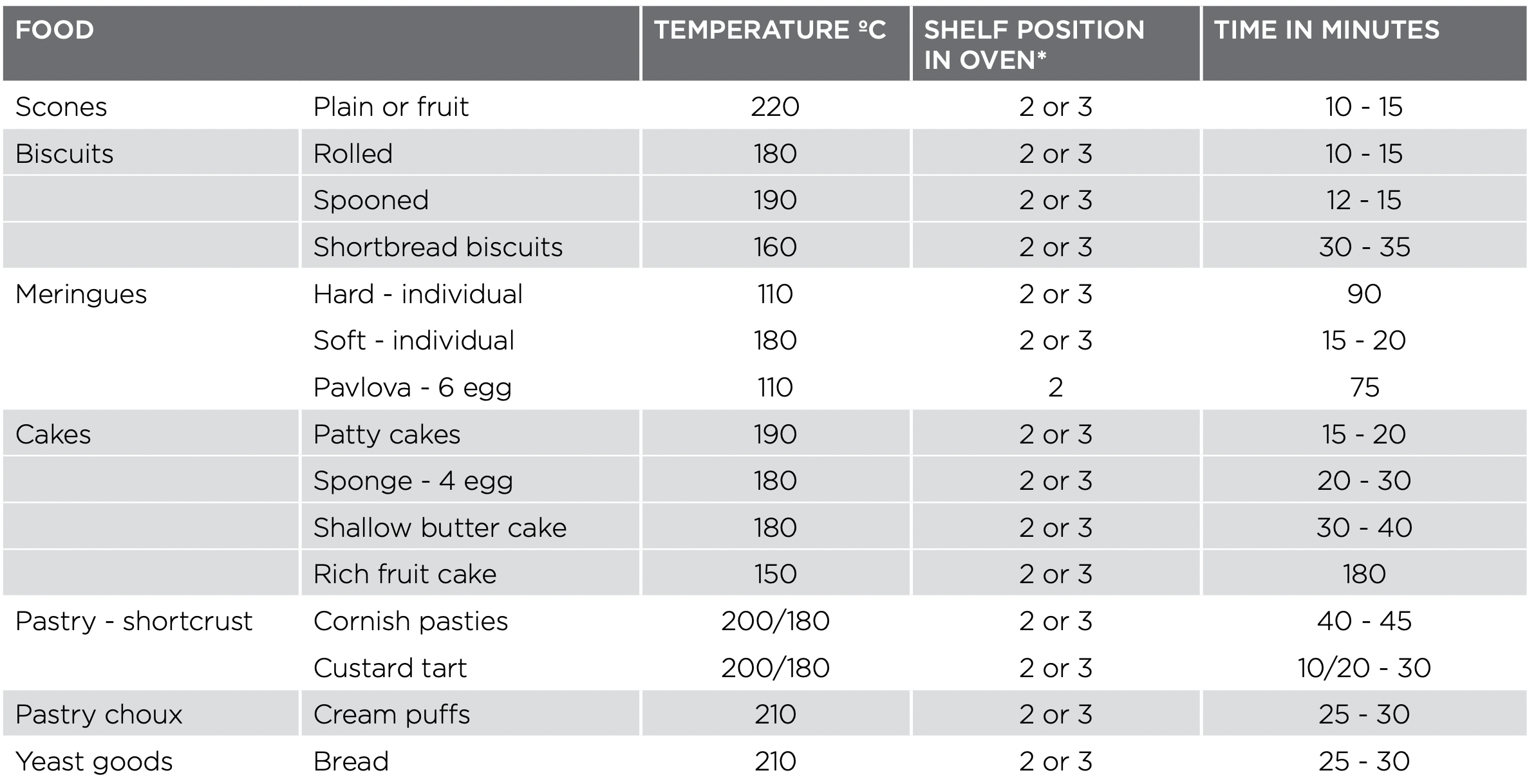
* Counting from the bottom shelf up. Refer to “oven shelf location” section for more detailed information.
Fan forced cooking

* Counting from the bottom shelf up. Refer to “oven shelf location” section for more detailed information.
GRILLING GUIDE
Grilling hints
WARNING
Always clean the grill/oven dish after every use. Excessive fat build up may cause a fire.
As a method of cooking, grilling can be used to:
- Enhance the flavours of vegetables, fish, poultry and meat.
- Seal the surface of the food and retain the natural juices.
NOTE: Below is a table indicating the door position whilst grilling for each of the product types.

This table shows how to grill different types of meat:
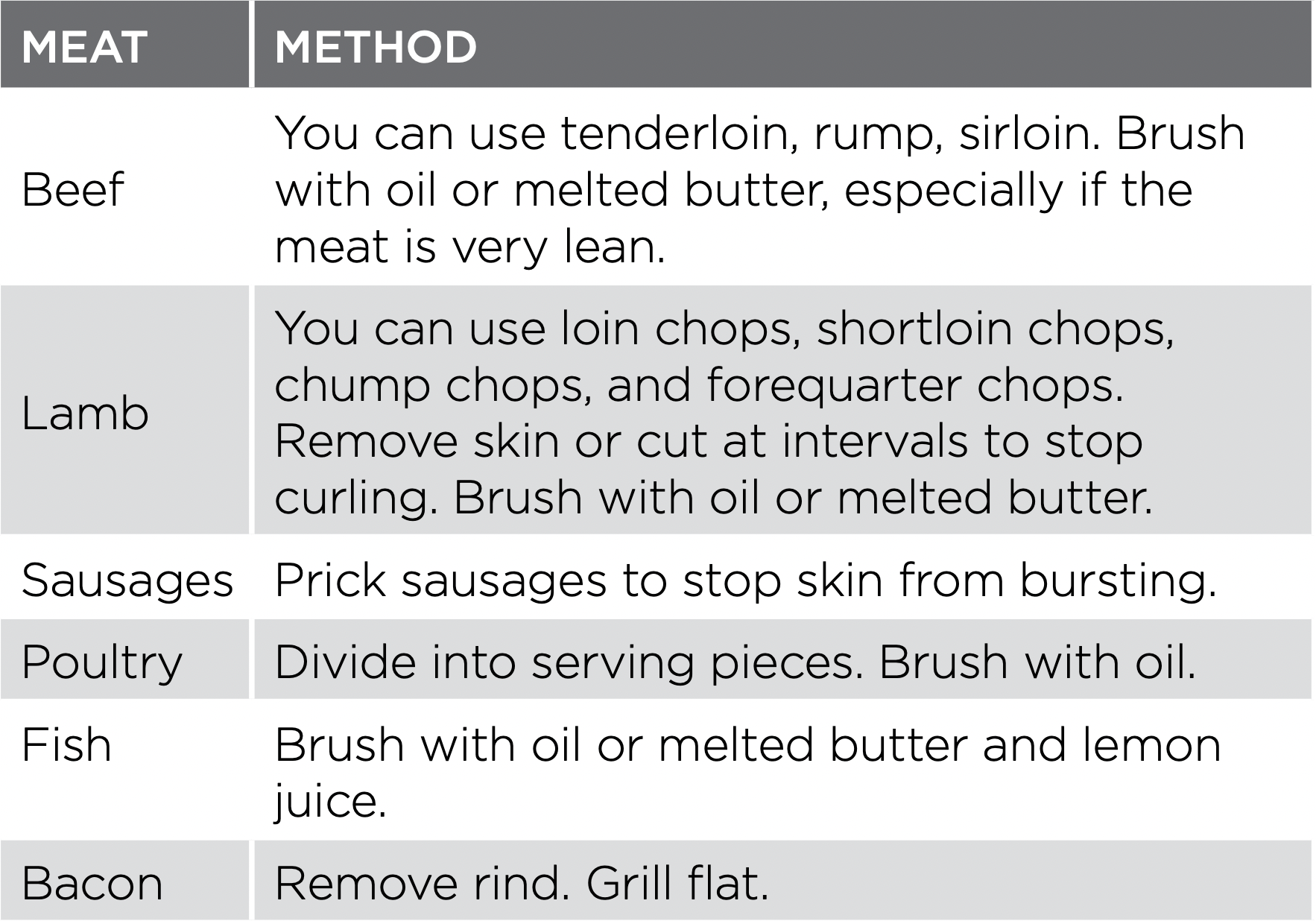
Guide to better grilling
IMPORTANT
Definite times cannot be given for grilling as it is dependant on the size of the food and your own tastes.
These times should only be used as a rough guide and remember to turn the food over halfway through the cooking process (except with fan grill).
For better grilling results, follow these easy instructions:
- Remove oven/grill dish and grill insert and preheat grill for about 3 minutes.
- Choose only prime cuts of meat or fish. If the cut is less than 5mm thick it will dry out. If the cut is more than 40mm thick, the outside may burn whilst the inside remains raw.
- Do not place aluminium foil under the food as this prevents fats and oils from draining away, which could result in a fire.
- Baste the food during cooking with butter, olive oil or marinade.
- Use tongs to turn food as a fork pierces the surface allowing juices to escape.

Fan grill (multifunction grill in oven models only)
If your appliance has fan grill as a function, this will assist the grilling process by circulating the heat evenly around the food. The recommended temperature setting is 180°C for all fan grilling functions.
- Place the oven/grill dish on the bottom rack.
- Place meat/poultry on an oven shelf above the oven/ grill dish.
- Wipe off any oil or fat which spatters while the oven is still warm.
There is no need to turn the meat as both sides are cooked at the same time.
Grilling with separate grill underbench
Your separate grill underbench appliance comes with a handle accessory to pull out and push in the grill tray frame.
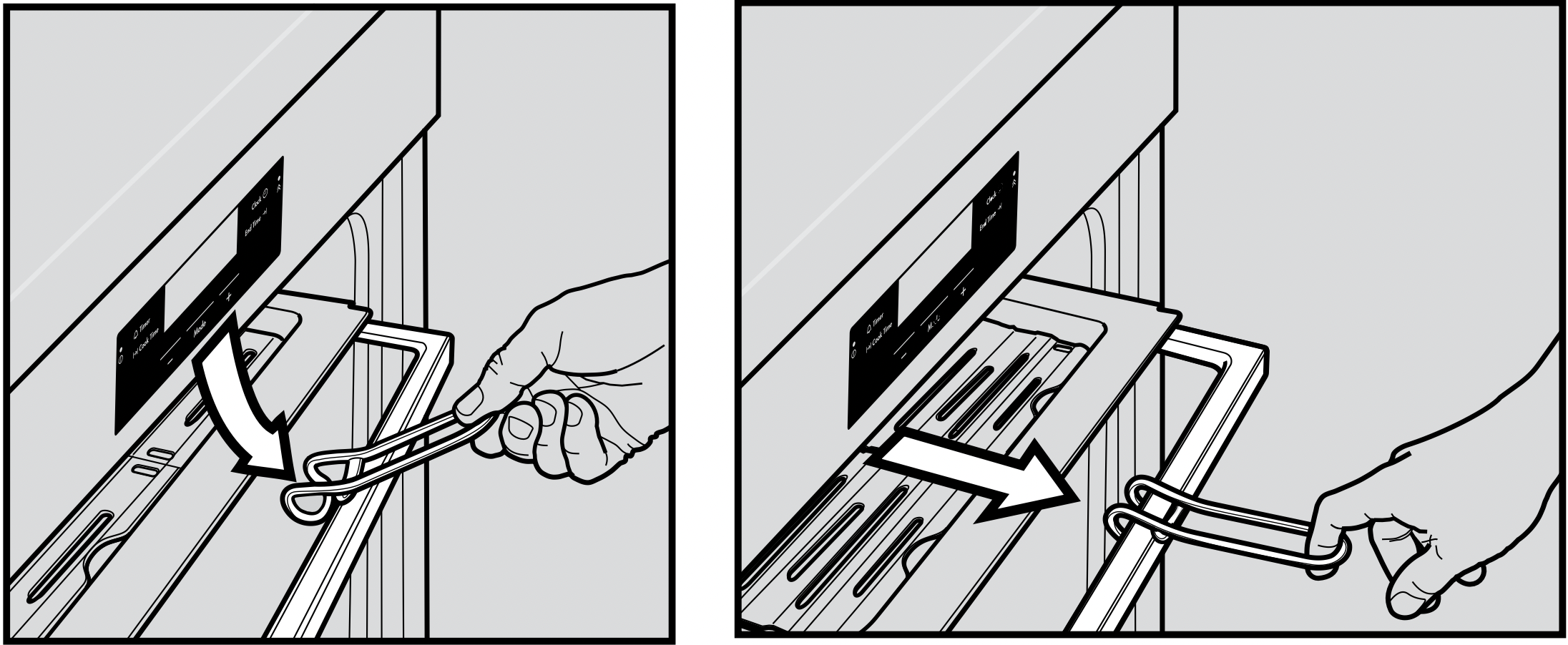
WARNING: Operating the oven may result in a hot grill tray frame even without the grill being used. As it may be a hot surface, it is not recommended to touch the grill tray frame directly.
DEALING WITH COOKING PROBLEMS
| PROBLEM | CAUSES | REMEDY | |
|---|---|---|---|
| Uneven cooking | Incorrect shelf position |
Select shelf that places food in the centre of the oven |
|
| Baked products too brown on top |
Experiment with other trays or dishes |
||
| Trays not centralised |
Centre trays |
||
| Air flow in oven uneven |
Rotate food during cooking |
||
| Grill dish affecting thermostat |
Remove grill dish from oven on bake modes |
||
|
Baked products too brown on top |
Oven not preheated |
Preheat the oven |
|
|
Baking tin too large for the recipe |
Use correct size tins |
||
|
Baking tins not evenly spaced |
Stagger baking tins at least 3cm between tins and the oven walls |
||
|
Products not evenly sized or spaced on trays |
Ensure products are same size and shape and are evenly spaced over trays |
||
|
Baking temperature too high |
Lower the temperature |
||
| Baked products too brown on bottom | Baking tin too large for the recipe |
Use correct size tins |
|
| Baking tins are dark metal or glass |
Change to shiny, light tins or lower the temperature by 10°C |
||
| Food too low in the oven |
Cook one shelf higher |
||
| Oven door opened too frequently during baking |
Don’t open the oven door until at least half of the cooking time has passed |
||
| Baking temperature too high |
Lower the temperature |
||
| Grill dish affecting thermostat |
Remove grill dish from oven on bake modes |
||
|
Cakes have a cracked, thick crust |
Baking temperature too high |
Lower the temperature |
|
|
Food too high in the oven |
Cook one shelf lower |
||
|
Cake batter over-mixed |
Mix just long enough to combine ingredients |
||
|
Pan too deep |
Check size of pan and use recommended size |
||
|
Baking tins are dark metal or glass |
Change to shiny, light tins |
||
| Baked products are pale, flat and undercooked | Baking temperature too low |
Raise the temperature |
|
| Food too low in the oven |
Cook one shelf higher |
||
| Baking time too short |
Increase cooking time |
||
| Incorrect tin size |
Use correct tin size |
||
|
Cake fallen in the centre |
Baking temperature too low |
Raise the temperature |
|
|
Baking time too short |
Increase cooking time |
||
|
Proportions of ingredients incorrect in the recipe |
Check recipe |
||
|
Opening door too early in baking |
Do not open the door until the last quarter of cooking time |
||
|
Roast meat and potatoes not browning in fan oven |
Poor hot air circulation Grill dish affecting thermostat | Elevate food onto a rack to allow air circulation Remove grill dish from oven on bake modes | |
|
Juices running out of meat |
Do not pierce meat with fork, turn with tongs |
||
|
Grilled meats overcooked on outside and raw in centre |
Grill at lower insert position | ||
|
Grilled chops and steaks curling |
Cut into fat every 2cm (1/2 inch) |
||
GETTING TO KNOW THE OVEN
Get to know the oven with this ‘Simple Test Cake’
Although we strive for a perfect performing oven, it’s possible that there will be some variation in colour when baking. Therefore, we suggest this simple, easy and delicious to make Simple Test Cake, it can help you understand your new oven. All ovens do sometimes have hot or cold spots, therefore it is important to judge with your eye as you may require to rotate during baking.
‘Simple Test Cake’
125g butter, softened to room temperature
1 cup caster sugar
1 teaspoon pure vanilla essence
4 large eggs
2 cups self-raising flour
Pinch of salt
4 tablespoons (80mL) full-cream milk
Method:
- Butter base and sides of 2, 20cm straight-sided round or square cake pans. Then line the base with grease proof or baking paper.
- Preheat oven to moderate ‘180ºC’ (170ºC fan forced) and ensure oven shelf is in the centre position of oven.
- Cream softened butter and sugar until light in colour.
- Add vanilla essence.
- Then add eggs one at a time, beating well after each addition.
- Sift flour and salt into the mixture and beat until well combined.
- Add milk and beat or stir to combine.
- Spoon mixture equally between prepared cake pans.
- Bake in preheated oven, middle shelf for about 25 to 35 minutes or until when tested with a fine cake skewer it comes out clean or the edges of the cakes have come away slightly from the sides of the cake pans.
- Remove from oven to wire cake rack and rest for 5 minutes before removing from cake pans.
See other models: WR42FX2002 WHI633BC WHC742BC 6341900 WRI500SB
Cool completely.
To serve: Sandwich together with your favourite jam or conserve, and dust top with pure icing sugar.
NOTE: If desired, substitute butter for either margarine or olive oil spread. Recipe is based on the Australian standard metric 250mL cup and 20mL tablespoon sets.
CLEANING YOUR APPLIANCE
WARNING
- Ensure the oven is electrically isolated before cleaning. This can be done by switching off the appliance via the powerpoint or isolating switch (if available), or the switchboard.
- Do not use steam cleaners, as this may cause moisture build up.
CAUTION: Do not use sharp metal implements or utensils on any surface, as these may leave permanent scratches or marks.
Enamel
Rub persistent stains vigorously with a nylon scourer or creamed powder cleansers.
NOTE: You can also use household oven enamel cleaners follow the manufacturer’s instructions carefully.
CAUTION
- Do not use harsh abrasive cleaners, powder cleaners, steel wool or wax polishes on enamel.
- Do not line the bottom of the oven or grill with foil or cookware.
Stainless steel
All grades of stainless steel can stain, discolour or become greasy. You must clean these areas regularly by following the procedures below, if you want your appliance to look its best, perform well and have a long life.
WARNING: Care must be taken when wiping exposed stainless steel edges.…they can be sharp!
CAUTION: The oven door and control panel are decorated with a special stainless steel that resists finger marks and should only be cleaned with warm water and a mild detergent. DO NOT use stainless steel cleaners, abrasive cleaners or harsh solvents.
NOTE: Make sure you follow the polish or brushing lines in the steel.
Glass
Glass surfaces on doors and control panels are best cleaned immediately after soiling. A damp cloth may help remove baked on food deposits. Oven cleaners can be used to remove stubborn marks and stains.
WARNING:
- The door glass on this appliance is made from a tough, durable material that withstands heating and cooling without breaking. As a precaution however, do not put cold water on hot glass. Should you have any questions about the glass in your new appliance, please contact the Customer Care Centre by dialling 13 13 49 (AUS) or 0800 10 66 10 (NZ).
- Door glass that is damaged should be immediately replaced.
CAUTION: Do not use harsh abrasive cleaners or sharp metal scrapers to clean the oven door glass since they can scratch the surface, which may result in shattering of the glass.
Oven
WARNING: Always keep your appliance clean. Ensure that fats and oils do not accumulate around elements, burners or fans. Keep the oven dish, baking trays, grill dish and grill dish insert clean, as any fat deposits may catch fire. Wrap your meats in foil or an oven roasting bag to minimise cleaning. Any polyunsaturated fats can leave a varnish-like residue which is very difficult to remove. The upper element can be released to assist in cleaning.
Grill
WARNING: Always keep the grill dish and grill dish insert clean, as any fat deposits may catch fire. Ensure that fats and oils do not accumulate around the grill element. The grill element can be released to assist in cleaning the top of the grill cavity.
Cleaning your oven accessories
Removing the trays and shelves from your appliance
- Slide the dish and shelves towards you until they reach the front stop.
- Tilt them up at the front to clear the side supports, taking care not to spill the contents.
- For separate grill underbench model (WVG655), open the grill door and pull out the grill slide to its full extent. Carefully lift the dish from the support.
- Lift the dish and shelves clear.
- Wash the dish, insert and shelves in hot soapy water.
- Reverse the above steps to put the grill tray and shelves back again.
- Ensure that they are placed between the 2 support wires.
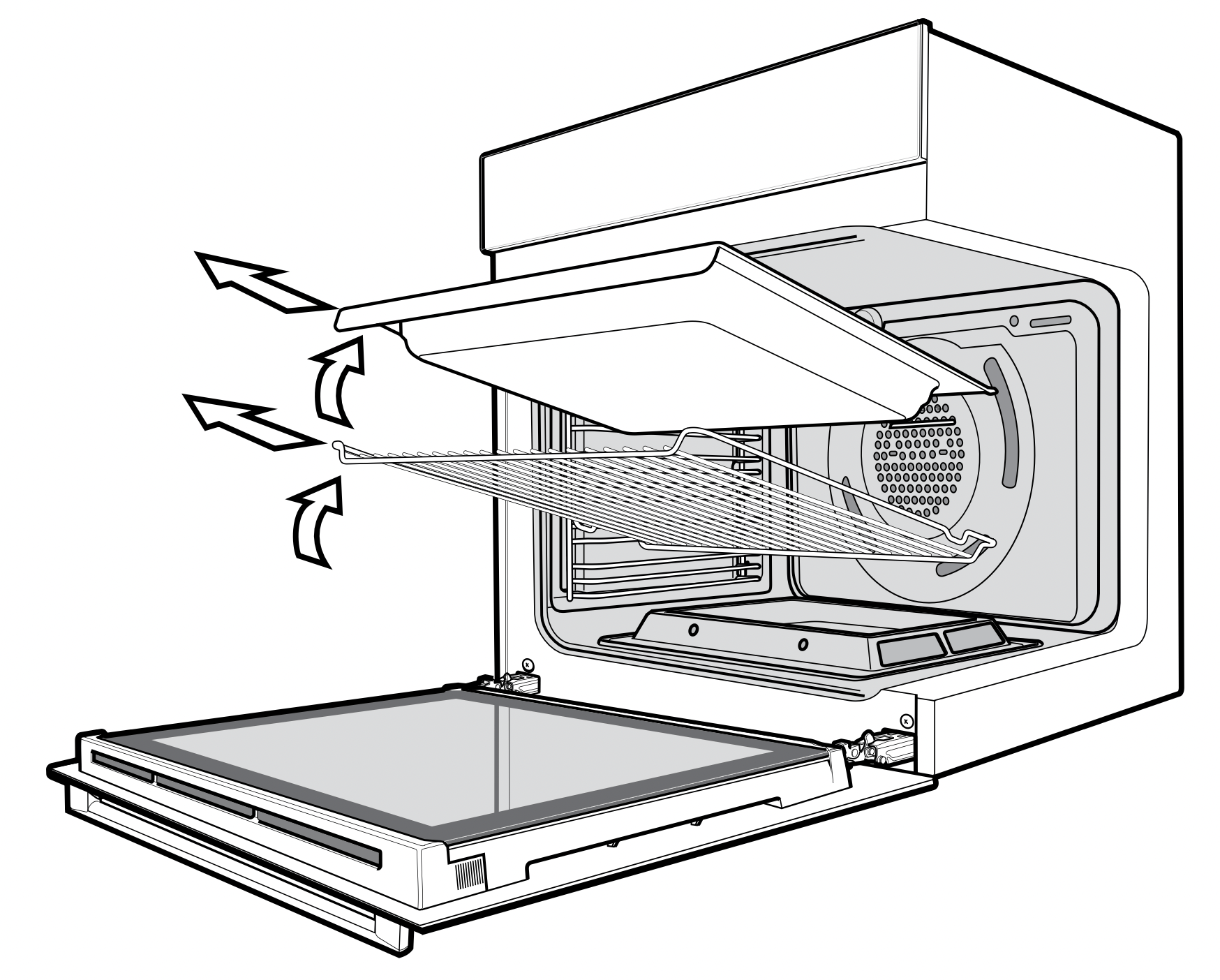
CAUTION: Do not remove the slide mechanism on the separate grill underbench model (WVG655). The grill dish can easily be removed for cleaning.
Removing the side racks
- Grasp the middle wire at the front.
- Pull firmly inwards while pushing back.
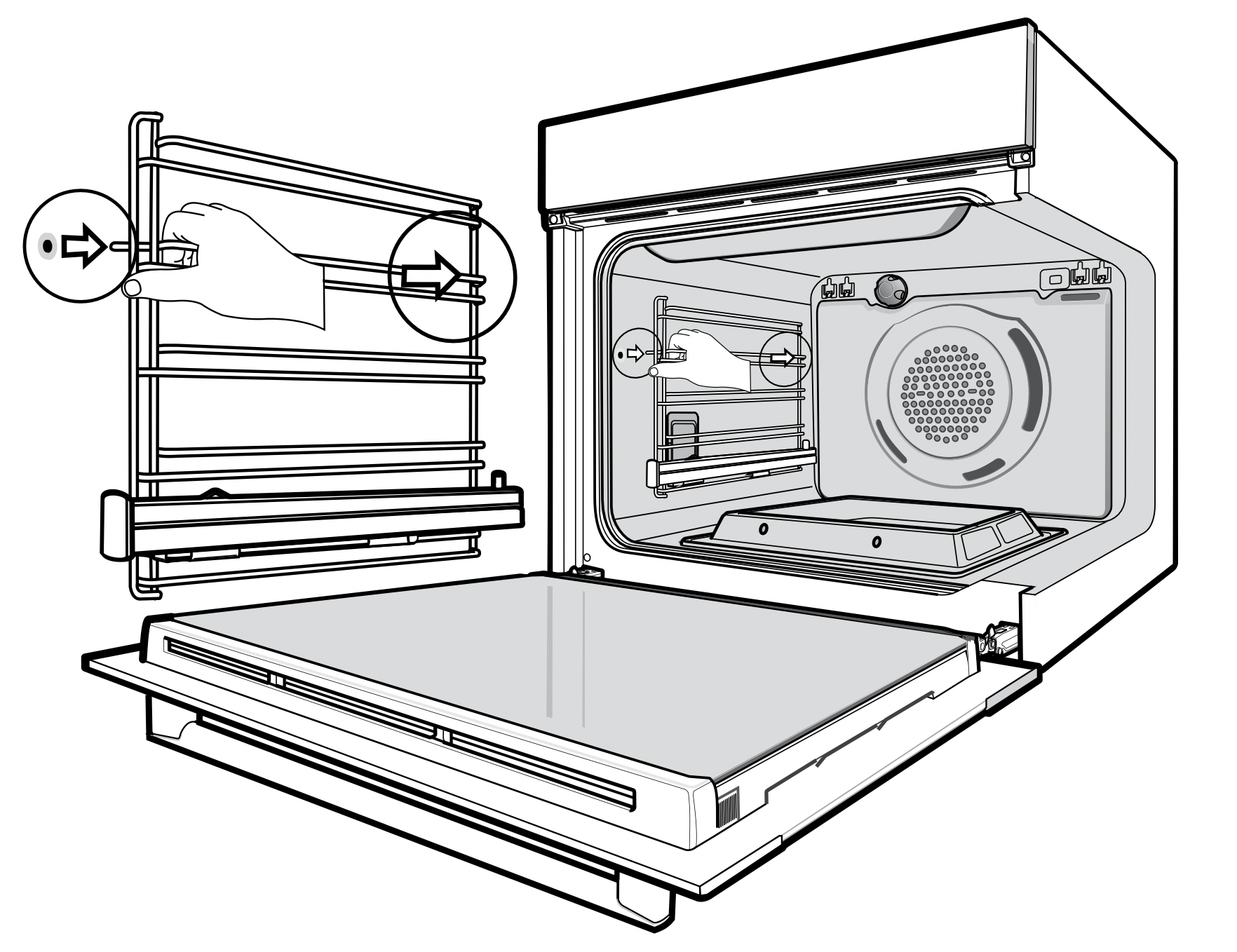
Releasing the grill element
WARNING: Make sure the appliance is turned off before you remove or replace parts, to avoid the possibility of electric shock.
The upper grill element is secured with a hanger clip which can be removed to help clean the oven cavity ceiling. To remove the hanging clip push the sides of the clip in the direction of the arrows. After cleaning raise the grill element and secure clip back into position.
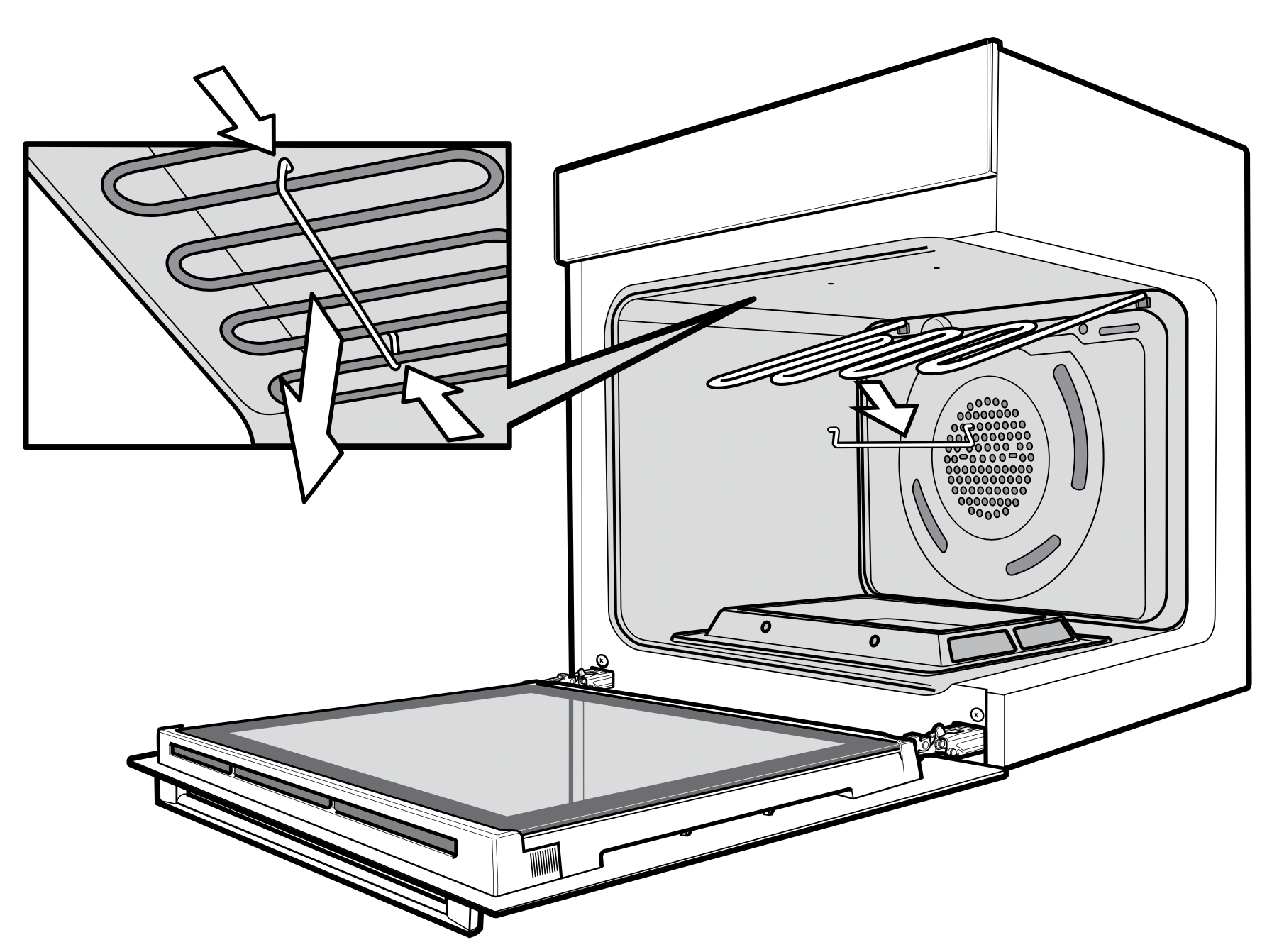
NOTE: Diagram shows a grill in oven model. Separate grill models use the same hanger clip arrangement in the grill compartment.
Removing and replacing the oven light
WARNING: Make sure the appliance is turned off before you remove or replace parts, to avoid the possibility of electric shock.
- Turn oven light glass anticlockwise to remove it for globe replacement.
- A special high temperature resistant globe should be used. This can be purchased from the Customer Care Centre.
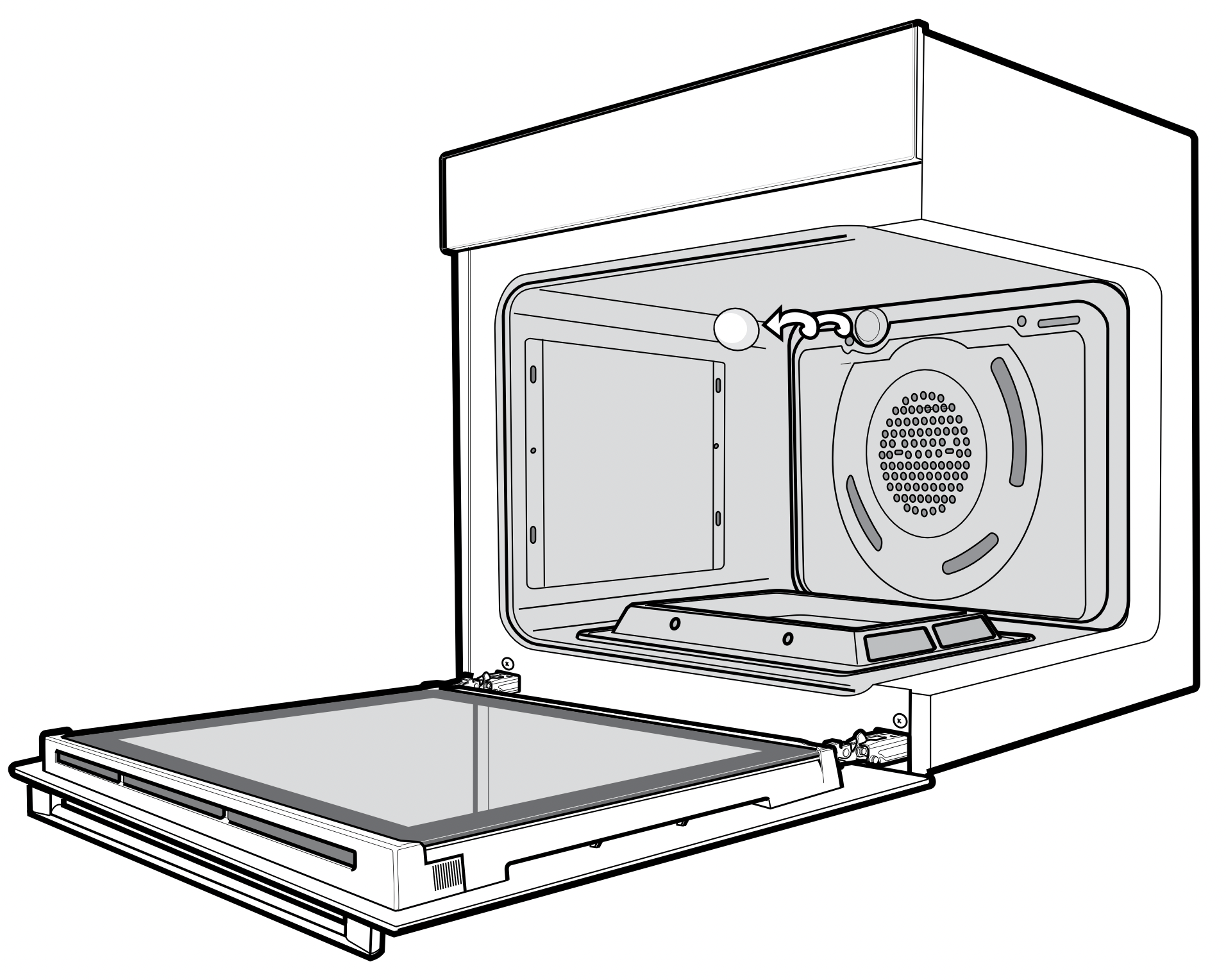
Cleaning the oven door
CAUTION: Do not lift the door by the handle. Rough handling will cause glass to break.
Removing the oven door
IMPORTANT: Your oven is equipped with a door that can be disassembled in order to clean all the panes of glass. Remove the door before cleaning.
- Open the door fully to access the hinges then rotate the ‘stirrups’ on both hinges fully towards the oven.
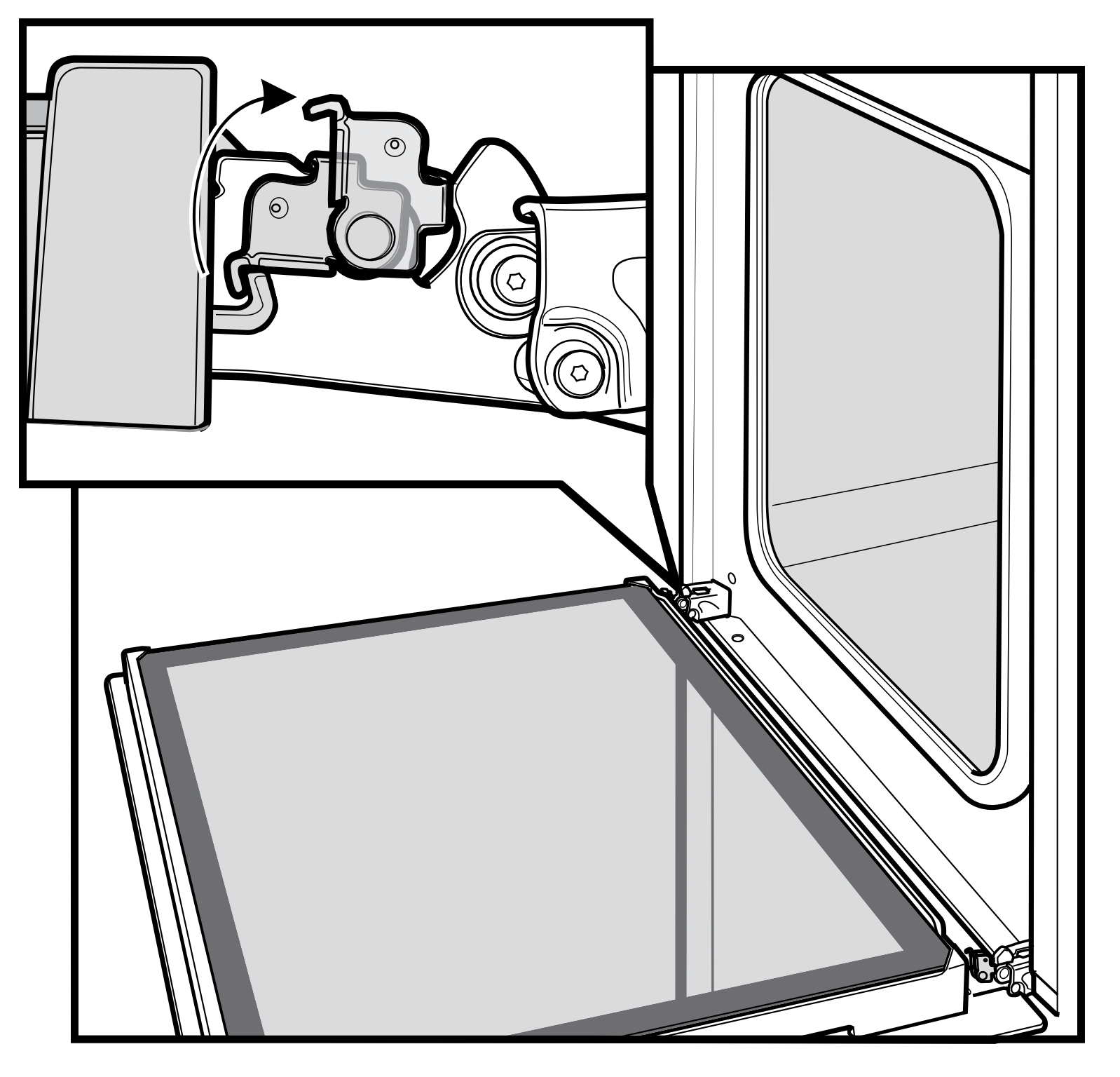
- Slowly close the oven door until it stops against the ‘stirrups’ (about 45°).
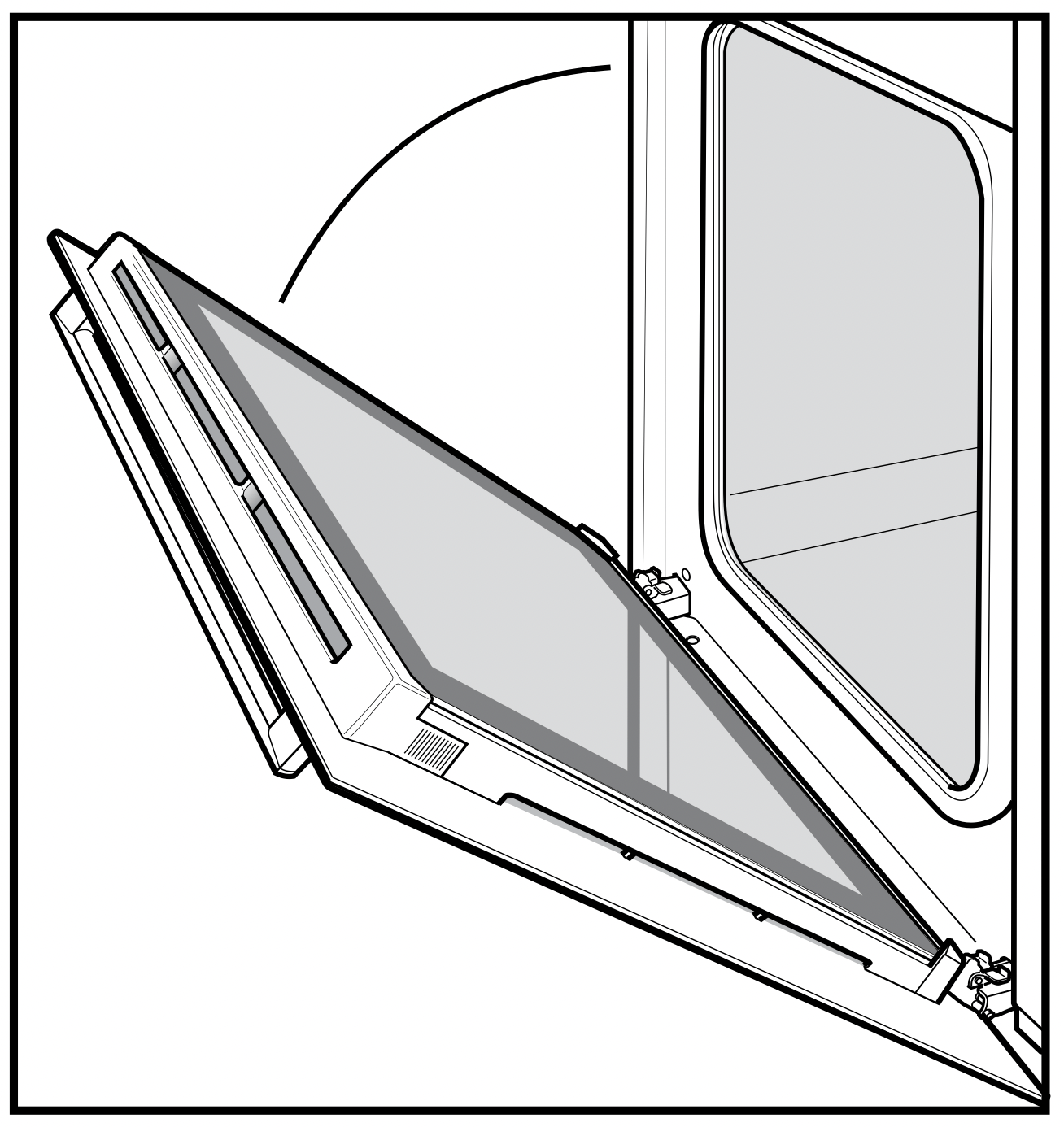
- Grasp the oven door with a hand each side of the door and remove it from the oven by pulling it towards you.
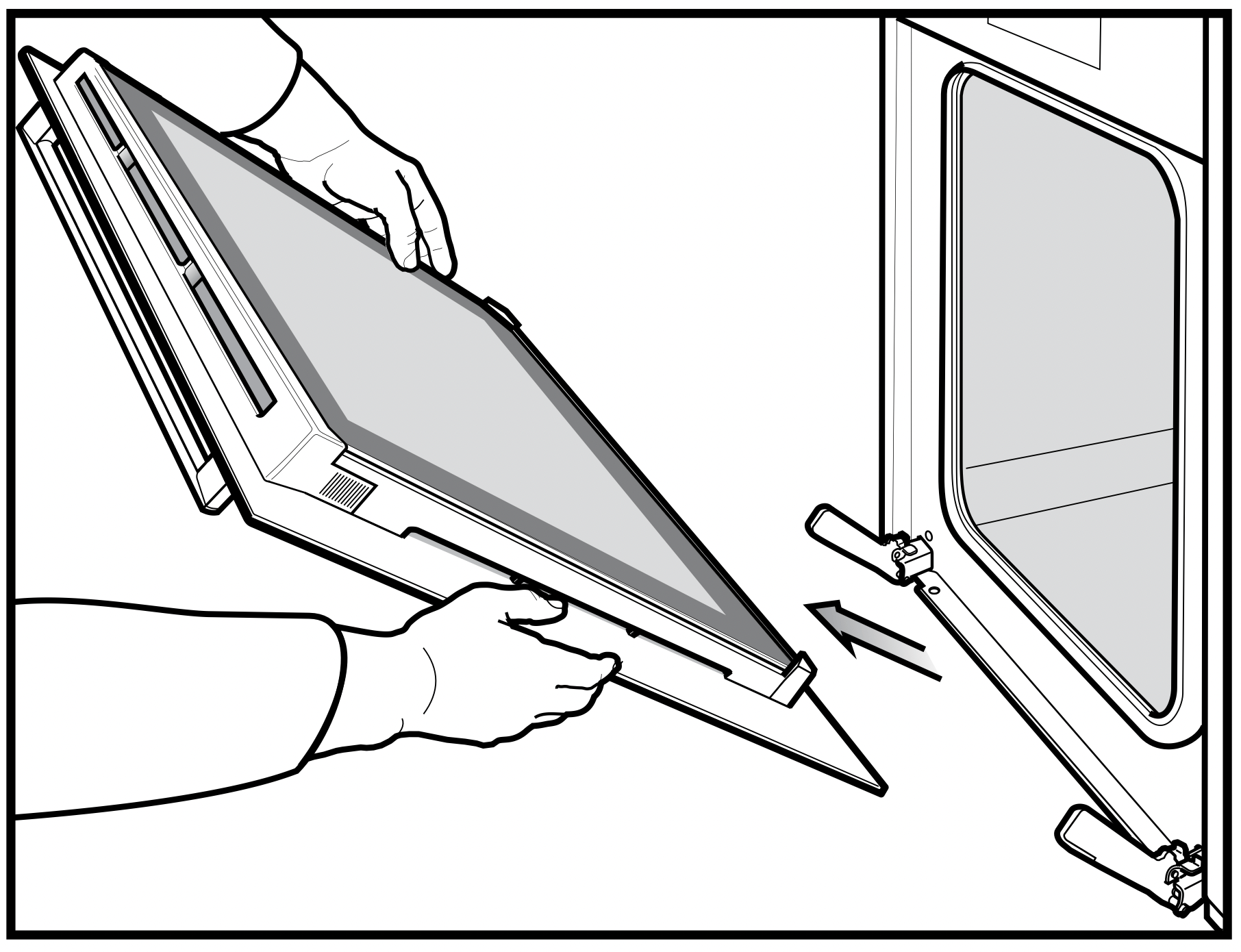
- Lay the oven door with the outer side facing downwards on something soft and flat (for example a blanket on a kitchen table) to prevent scratches.
Removing oven door top trim
- Take hold of the grid embossed sections of the door trim at each end and press inwards to release the clips. Remove the door trim by pulling it towards you.
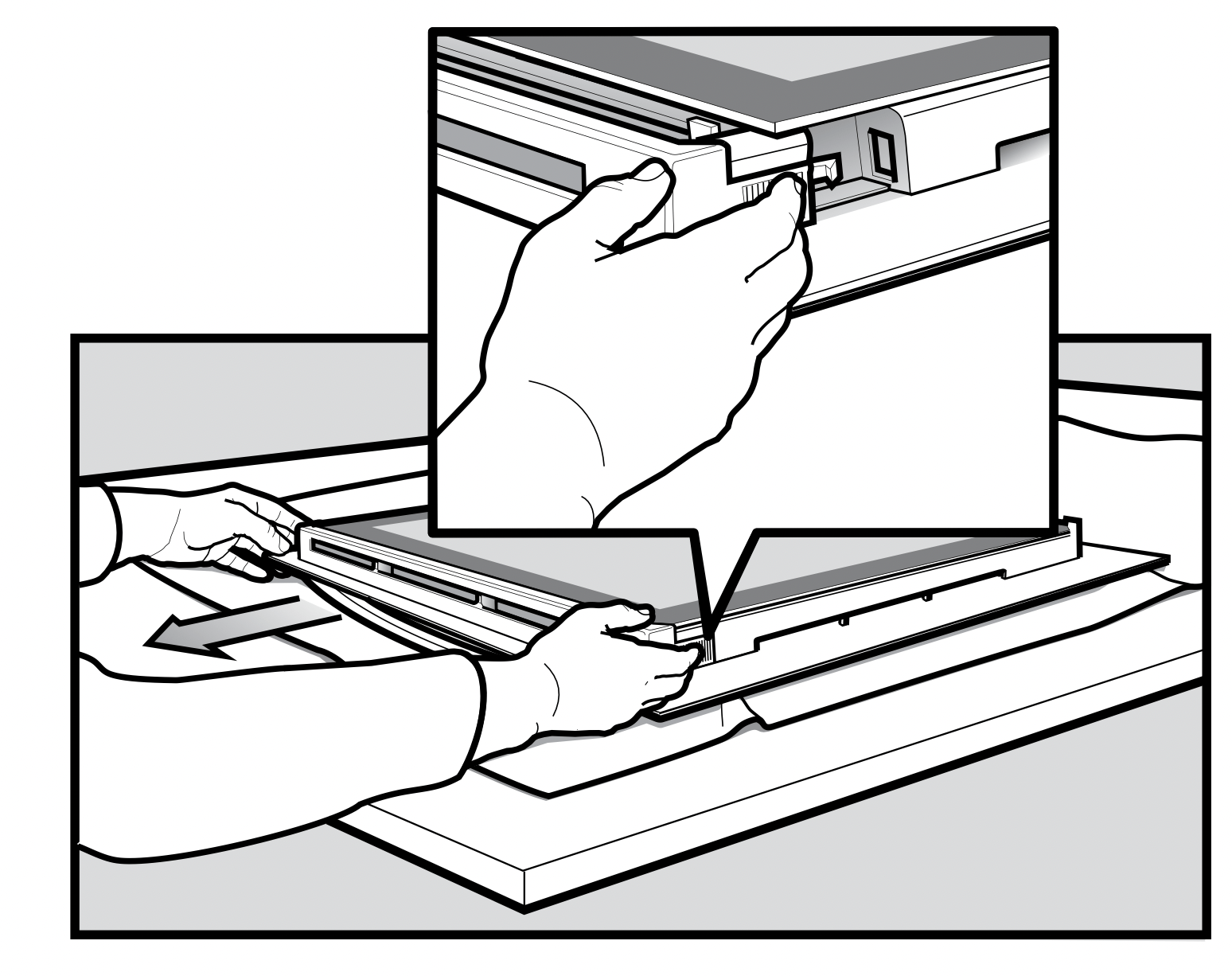
Removing the door glass panels
CAUTION: Rough handling, especially around the edges can cause the glass to break.
- Lift the black bordered glass panel out of the guide.
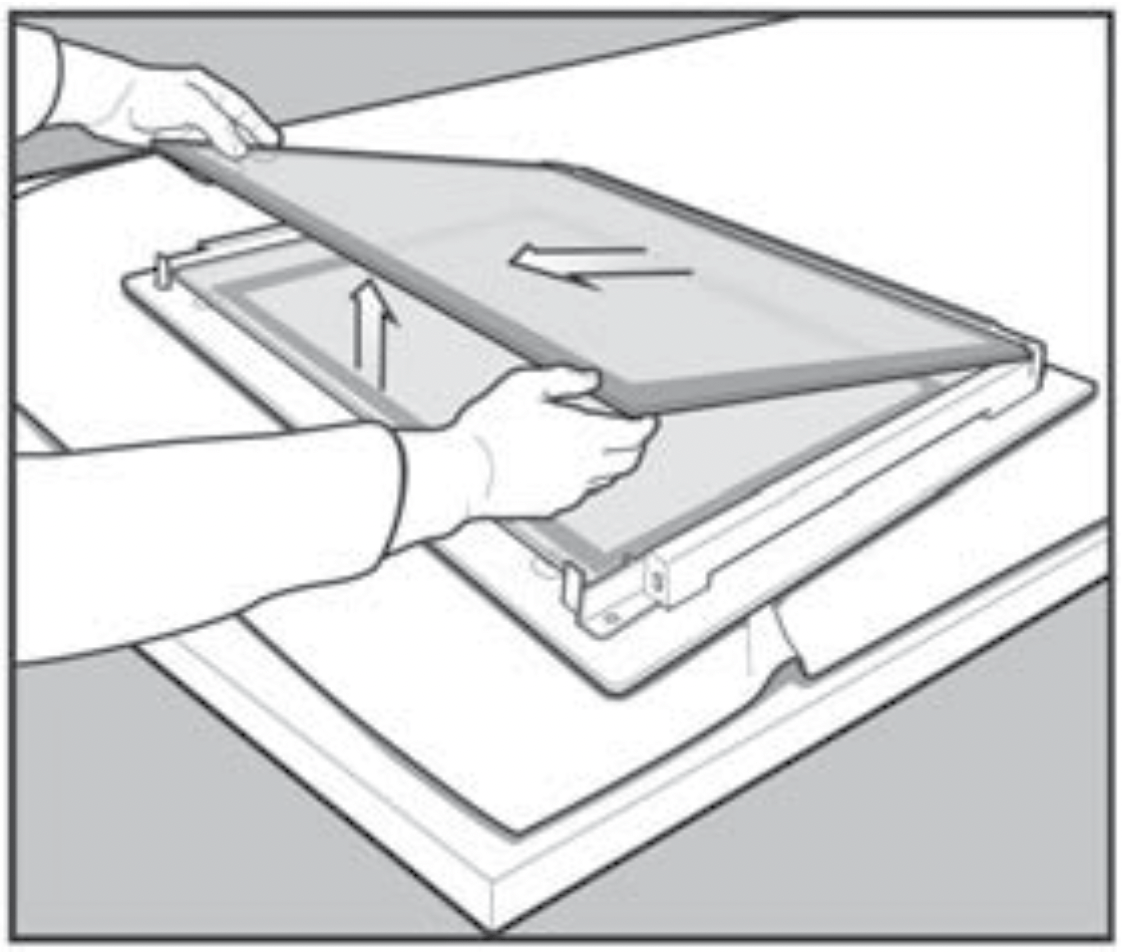
- Repeat this for the smaller clear glass panel (when fitted).
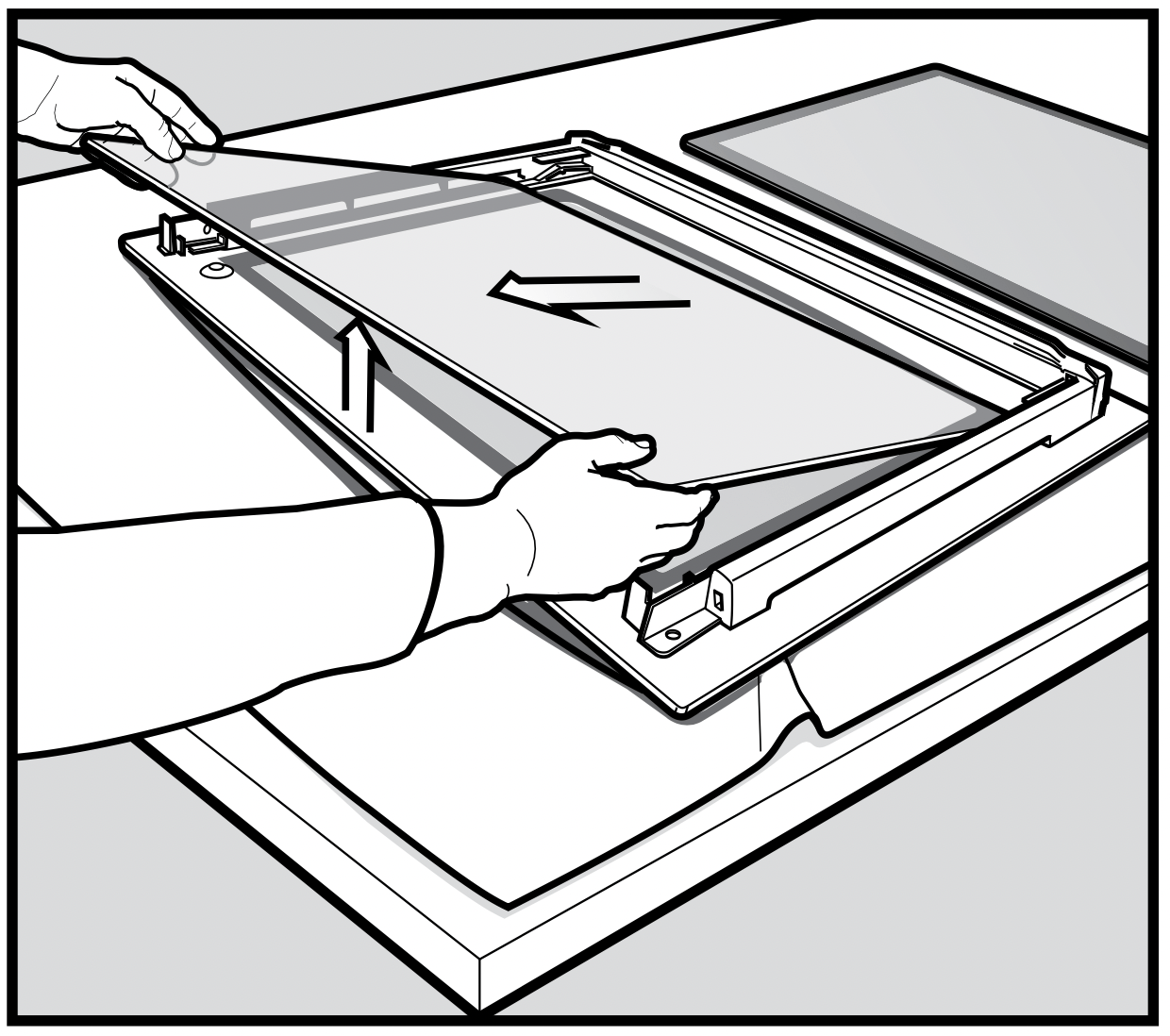
Cleaning the door glass panels
CAUTION: Do not to use harsh abrasives on the glass panes as the reflective surface plays a role in the function of the oven. Do not place glass in dishwasher. Hand wash only with a soft cloth and warm soapy water. When dry, polish with a soft cloth and ensure the glass is dry before reassembly.
Removing the bottom trim (on selected models)
- The bottom trim may be removed for cleaning by snapping out and lifting away from the glass.
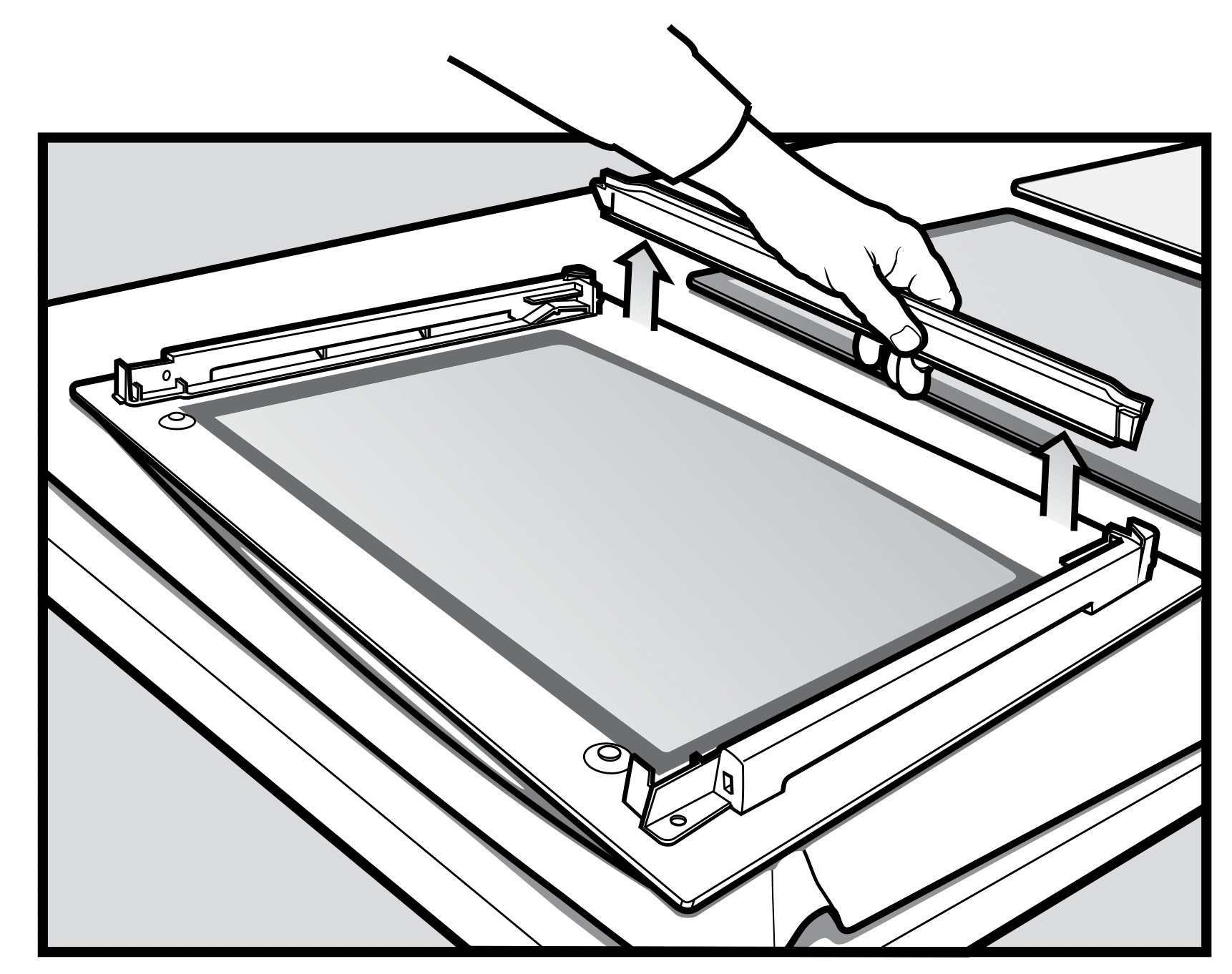
Re-assembling the bottom trim (on selected models)
- Push down to “snap” each side of bottom trim back into door columns.

Re-assembling the door glass panels
- Insert the smaller clear glass panel (when fitted) first from above and at an angle to the profile of the door.

- Repeat for the black bordered glass panel ensuring the painted surface is facing to the downside.

Re-assembling the top door trim
- Take hold of the top door trim at each side and position it to the inside edge of the glass.
- Push the trim down with its top edge over glass panel until the clip snaps in on each side of the trim.
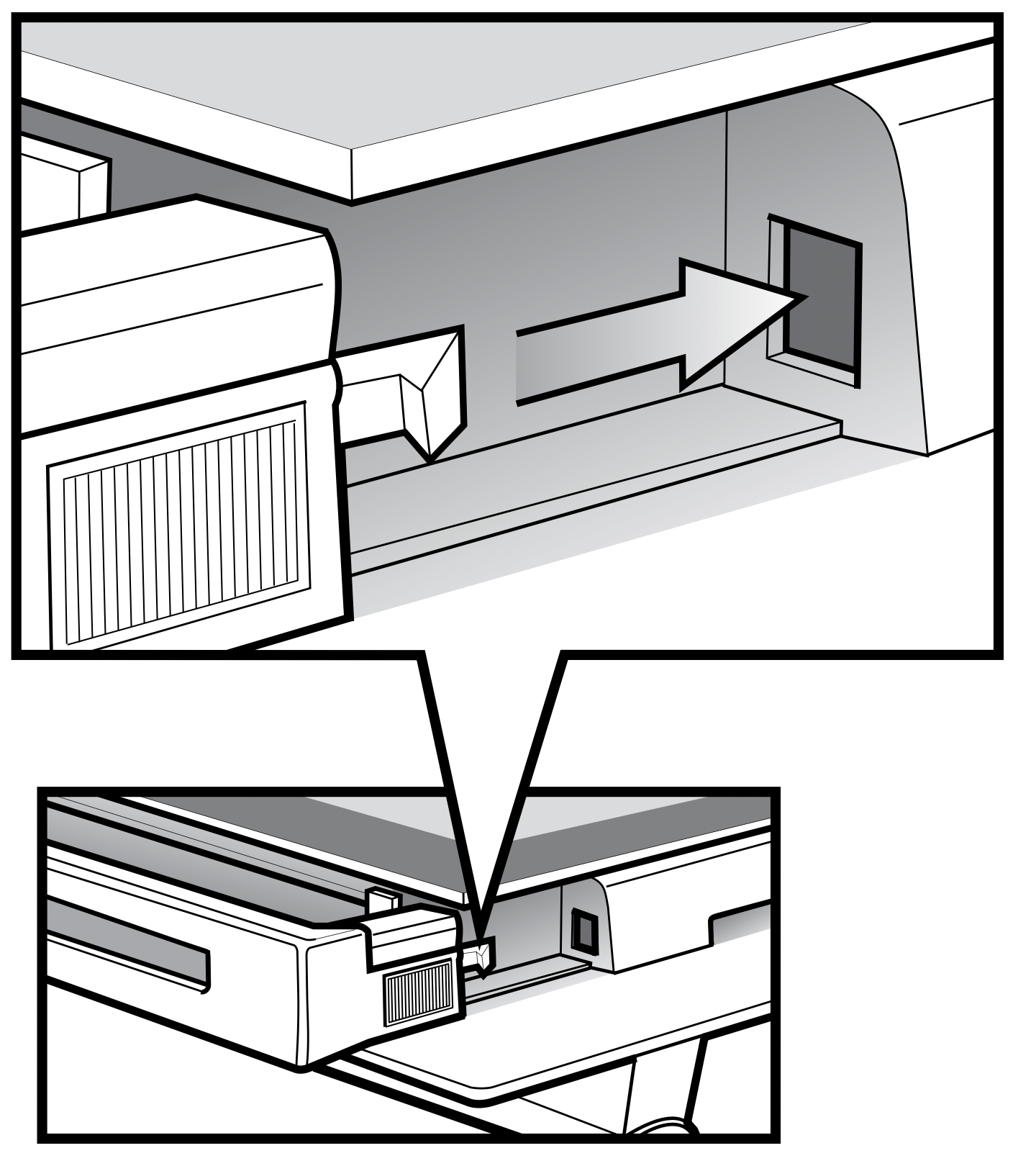
- Push the middle of the trim down to ensure it is straight and firm against the glass panel.
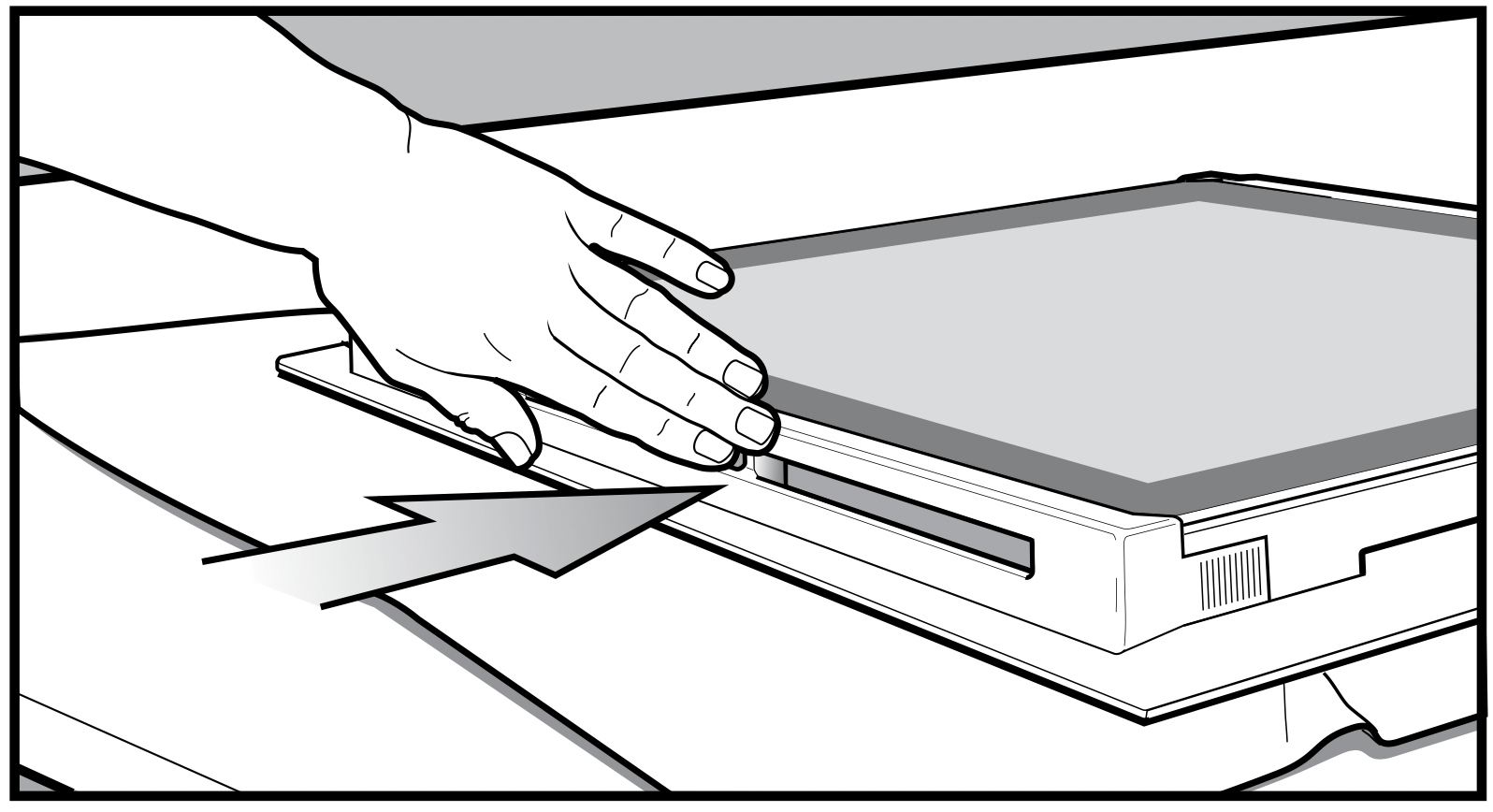
Fitting the oven door
- Take hold of the oven door with a hand on each side and with the door at an angle of 45º, position the recesses at the bottom of the door onto the hinge arms of the oven. Let the door slide down the hinge arms as far as it will go.
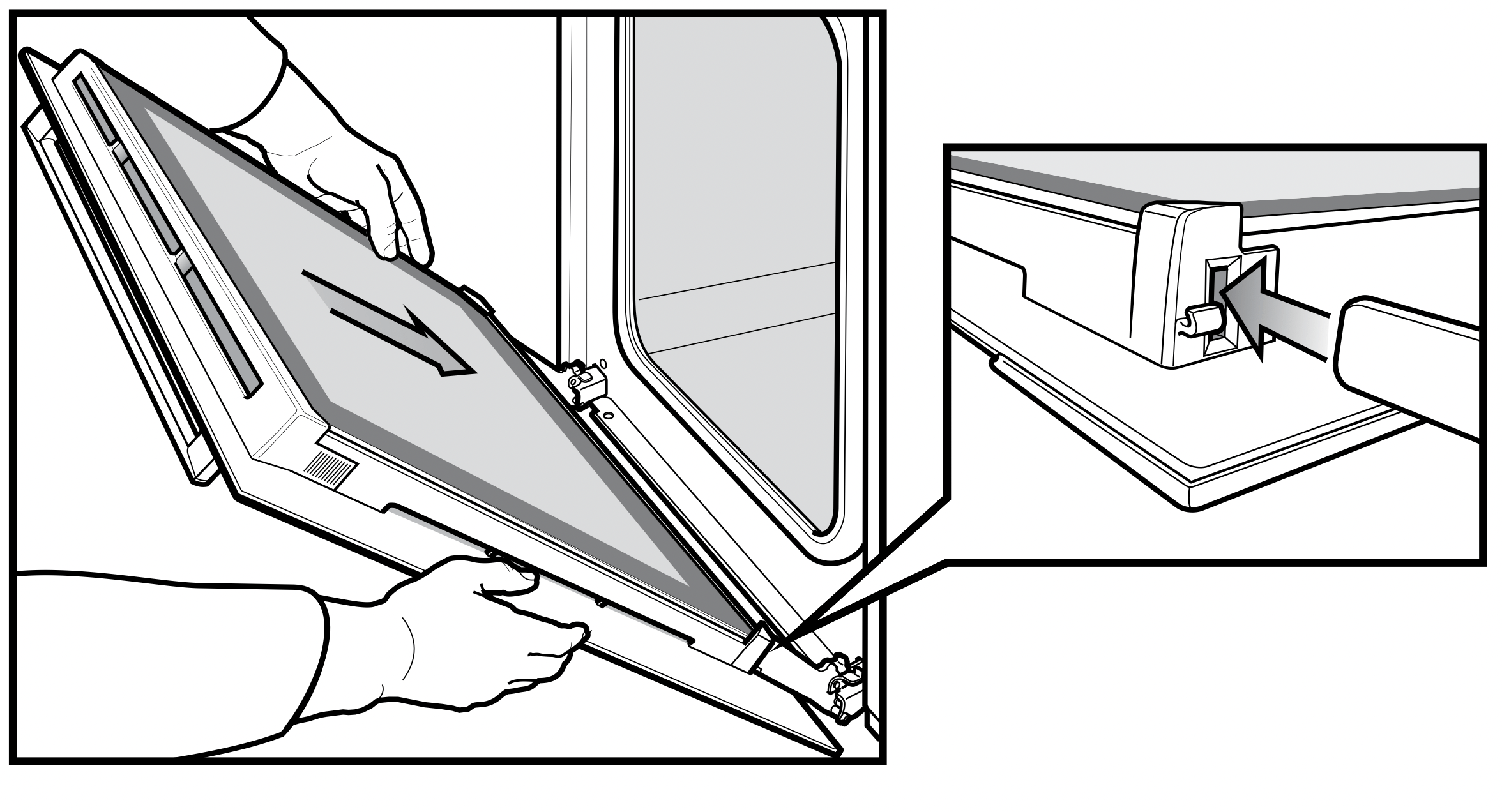
- Open the door fully to access the hinges.
- Rotate the stirrups (see image below) until they lock into the hook. The oven door may now be closed.

TROUBLESHOOTING
Faults
If there is a problem with the oven and/or grill, please:
- Check the points listed below before calling for service. It may be possible to avoid a call by fixing the problem yourself – and so continue cooking.
- For cooking problems refer to “Dealing with cooking problems”.
NOTE: We may charge for service even in the guarantee period if your problem is due to the causes listed below.
Data Plate
When you need information, service or spare parts please be prepared to tell us the:
- Model number
- Serial number
These are shown on the data plate. The data plate is visible when the oven or grill door is open.
If you need more information, please contact the Customer Care Centre on 13 13 49 (Australia Centre is open 8.00am – 5.00pm Monday – Friday Eastern Standard Time) or 0800 10 66 10 (New Zealand – Centre is open 8.00am – 5.00pm Monday – Friday).
If you have a warranty or spare parts enquiry, you should call the number listed on the back page.
| PROBLEM | POSSIBLE CAUSE |
|---|---|
| Oven or grill not working |
NOTE: If the household fuse continues to blow, call the Customer Care Centre. |
| Oven light not working |
NOTE: If the household fuse continues to blow, call the Customer Care Centre. |
| Oven not heating enough |
NOTE: If the household fuse continues to blow, call the Customer Care Centre. |
| Oven not working |
NOTE: If safety shutdown persists, call the Customer Care Centre. |
| Timer flashing on display |
NOTE: Reset time of day and any cooking functions you were using. (Refer to TIMER operating instructions) |
| Appliance smoking when first used |
|
| Door cannot be replaced after removal |
|
| Excessive heat or condensation on control panel or knobs |
|
| Hot air blowing from above the door |
|
| Shelf or telescopic runner slides out when door is opened. |
|
| The oven seal is loose |
|
NOTE: Only authorised personnel should carry out servicing.
